#this is the source image for the potential cover
Text


#my art#saitama#tatsumaki#saitama x tatsumaki#saitatsu#saimaki#i really wanna to make a fan comic or doujin as us weebs know it as#this is the source image for the potential cover#hope to have more to show you guys!
169 notes
·
View notes
Text
The Beforan ancestors are so...
We know nothing about them. We know exactly who they were. Not one of them has ever spoken a single line in anything even canon-adjacent. Everyone can agree that He Would Not Say That. We know their full legal names. We don't know what anyone called them in adulthood. We can make some pretty solid predictions about their interpersonal relationships. We don't know which of them were even alive at the same time. We only know they exist because of a bunch of parodies of 2012 tumblr.
#homestuck#beforus#just fascinated by the way the structure of homestuck makes it really really easy to analyze these characters who are inherently absent#pre-scratch feferi is the only one whos so much as alluded to the rest are barely implied#but unlike say dad crockers mom we know for a fact that they existed and we can talk about them with canon support#we cant prove anything because again they are not discussed in canon but#we know they lived on beforus#we know that most if not all of them arrived long before the dancestors#(see post scratch handmaid for evidence of potential exceptions)#we know their 'role' was to prepare their descendants for sburb#we know they were cloned in an ectobiology lab on a meteor and karkat was there#(ig technically they appear on panel in that one image of karkat getting covered in grubs since that was pre-portal but...)#we know feferi was the empress#everything else we have to extrapolate from what we know about beforus#(and everything we know about beforus is extrapolated from interactions with 12 long dead teenagers who hadnt been on the planet for years)#and what we know about sburb/sgrub and what we know about the main trolls and the alternian ancestors#we have five different sources for seer/knight interactions that we can apply to the beforan karkat/terezi dynamic#we know who vriska is when she models herself after mindfang and we know who mindfang was and we know who non-mindfang aranea is so...#we know how kankri talks about his mutation and we know what happened to the signless and we know who karkat is and we know feferi#we can make some really good guesses!#we dont even know if adult tavros had wings
20 notes
·
View notes
Text
Guys, A.I. has no idea what "Idaten Jump" is LMAOOOOOO

Like it legit gave me GIYUU TOMIOKA instead of SHO lmaooooooooo

I did try to give in as much input as I can though but welp, see the results for yourselves




Yea....we are doomed.
So...tldr-

#idaten jump#ai artwork#ai generated#ai image#ai art#ai doesn't know what Idaten Jump is#this is actually kinda hilarious lol#rip potential art making source for this fandoms#ig we have to do it ourselves#ai do be dumb#like WHAT was even the similarity there#im disappointed :/#the reason I chose Sho since yk he's the main protagonist appearing in every official Idaten Jump cover ever lol#but the fact ai doesn't know HIM gives me absolutely no hope for the rest of the crew#rip#wasted potential
3 notes
·
View notes
Text
Welcome to a topsy-turvy Wet Beast Wednesday where I'm discussing one of my favorite cnidarians, the upside-down jellyfish. These are 8 species of jellyfish in the genus Cassiopea, which is the only member of the family Cassiopeidae. What makes these jellies notable is the fact that they spend most of their time lying upside-down on the seafloor.

(image: an upside-down jellyfish swimming. It has a light brown and white striped bell and multiple tentacles that are tuck and white. The tentacles branch and are lined with feathery, light brown structures)
While the majority of jellyfish are predators who drift through the water at the mercy of the currents, upside-down jellyfish have essentially become farmers. Their eight branched oral arms that contain symbiotic algae called zooxanthellae. These algae are photosynthetic and live in a mutualistic relationship with the jellyfish. The jellyfish gets food from the zooxanthellae and they get protection from predators and a place to live. Upside-down jellyfish can survive entirely on the nutrients produced by the zooxanthellae, but they will still feed on zooplankton and other small prey. Upside-down jellies are not the only jellyfish to utilize zooxanthellae, many other species also survive primarily on their symbiotic algae, but they are the only ones to have adapted the benthic lifestyle. They can reach a bell diameter of up to 25 cm (10 inches), or as one source for this stated: about the size of a pie pan.
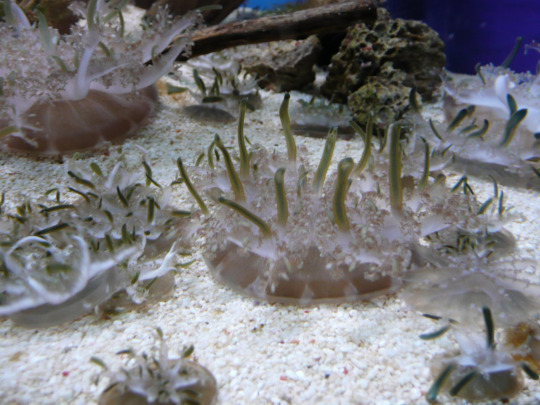
(image: multiple upside-down jellyfish lying on sand. They are ov various sizes and mostly light brown, but have thicker, green tentacles sticking op)
Upside-down jellyfish are found in warm coastal waters in Florida and the Caribbean and in Micronesia, Melanesia, and parts of Polynesia. They require shallow waters to allow enough light to reach their zooxanthellae and are usually found on shady or muddy bottoms. They are highly associated with mangroves and may play an important role in the mangrove habitats by mixing the water to recirculate oxygen and nutrients. They are rarely found alone, instead congregating in large groups that can cover portions of the seafloor. They attach by using their bells as suction cups and rhythmically pulse using the edges of the bell. This pulsing forces water over the gills and can force zooplankton into the stinging cells to become food. Stung prey will fall on the oral tentacles, where it is broken down into fragments that are then intaken through the numerous tiny oral openings on the tentacles. Interestingly, some species have cycles of reduced movement, which is believed to be the first known example of sleep in an animal without a central nervous system. While upside-down jellies can swim, they will usually only do so to escape predators or if their environment becomes unsuitable.
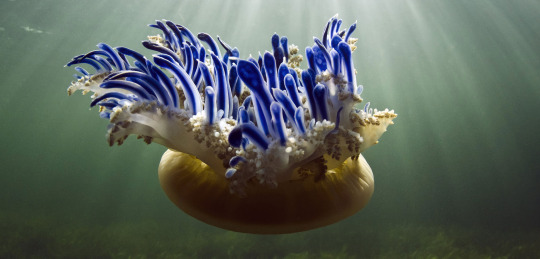
(image: an upside-down jellyfish swimming. The majority of its body is light brown, but it has many tentacles that are dark blue and outlined in white)
While a very neat thing to see underwater, many snorkelers avoid upside-down jellyfish due to a phenomenon called stinging water. This is when people will receive the symptoms of a sting by the jellyfish without actually touching it. While the cause of this was a mystery for a long time, it was solved when a 2020 paper was published in Communications Biology by Ames et al. The scientists discovered that upside-down jellies release clumps of mucus into the water. This mucus is filled with zooxanthellae and stinging cells and many of these clumps also have ciliated cells that allow for limited swimming. These clumps, named cassiosomes, are the source of the stinging water. The paper, titled "cassiosomes are stinging-cell structures in the mucus of the upside-down jellyfish Cassiopea xamachana" speculated that the cassiosomes are used for defense and feeding. The cassiosomes could be released to sting a potential predator from a distance, discouraging it from approaching the jellyfish. Presumably snorkelers trigger this defense when they swim over the jellies, resulting in stinging water. They could also be used to catch prey as zooplankton killed by the stinging cells would have a high likelihood of falling onto the jelly that released them. Because the cassiosomes have zooanthellae in them, they could survive for likely up to several days after release.

(image: a microscope image of three cassiosomes. They are irregularly-shaped blobs somewhat similar to popcorn. They are a dark color with grey outlines. Spots of green algae and white stinging cells dot their surface)
Upside-down jellyfish are threatened by habitat loss as many mangrove forests are torn down for development. They are also threatened by pollution. They are not considered dangerous to humans. The sting of an upside-down jellyfish can result in mild to severe rashes and itching, but is not lethal.
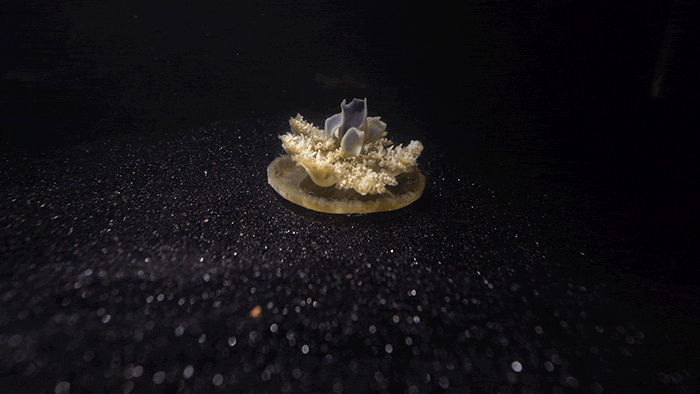
(gif: a lone, light brown upside-down jellyfish on black sediment. The edge of its flat, circular bell regularly pulse upward to move air over its gills and tentacles. This one's pulsing has slowed, which is speculated to be the result of it going through its sleep cycle)
#wet beast wednesday#upside down jellyfish#inverted invertebrate#marine biology#biology#zoology#ecology#animal facts#jellyfish#cnidarians#invertebrate
841 notes
·
View notes
Text
Tarot Hellenic Deity Communication Post that should probably be a book someday.
Hello,
Feeling inspired by some other posts about Deity identification via tarot I wanted to tweak their ideas and add some additional strategies that help me.
This is a devotional post to two of my patron Gods, Lord Apollon and Lord Hermes, who are assisting me with my Oracular duties.
Praise Apollo and Hermes.
Post index:
My Background
Some notes about this post
The Major Arcana: Intro
The Major Arcana Deities
The Minor Arcana Part 1: How to incorporate the Minor Arcana
The Minor Arcana Part 2: The Suits
The Minor Arcana: Part 3: The Courts
Pentacles
Swords
Wands
Cups
The Minor Arcana part 4: Notable Pip Cards
A Note on Gender
A Note on Symbolism
What the Hermes? (important!)
Deity Communication troubleshooting
How to incorporate Shufflemancy as a Tarot reading clarifier (link to another post)
Notable sources (used in addition to my own knowledge & research)
My background:
I started Tarot at the age of 11 (2001) and own dozens of different tarot and oracle decks, my exposure to various interpretations over almost 2.5 decades has allowed me to appreciate the nuances in interpretations and even assigned deities.
As such, while I do know the broader meanings of each card, I also check the interpretation provided by various deck creators as their own divine guidance adds to my work.
E.g. The Tower in my Murder of Crows deck has a very different vibe to The Tower in my Gold Lyre tarot deck.
I will be covering deck design nuance after the list of card deities.
Some notes about this post:
Firstly: I will only be listing Hellenic deities as I currently work with the Hellenic Gods and while I have worked with the Kemetic Gods briefly, I have a distant while cordial relationship with them.
I had worked with the Norse Gods for 3-4 years prior to moving to my current locale, however I acknowledge that my time with them has passed (at least for now) and I want to limit this to one pantheon.
Secondly: In some of the other posts that assign deities to tarot cards, I found it odd that they would assign say, Freyja to some cards but not Aphrodite, arguably Freyja's Greek counterpart.
As such, I will be taking care to check that I don't miss any deities due to these overlaps however this means that some deities will be gaining more cards than typically assigned.
Note that some of the Gods of other pantheons have multiple equivalents in the Hellenic Pantheon so in the case that occurs, I will do my best to select whichever one already has their Hellenic equivalent listed by other sources and in cases that hasn't occurred, I will select/assign whichever Hellenic God/s best fit the card.
Thirdly: I won't be assigning deities to each of the numbered minor arcana for a couple of reasons;
1. Not all decks have imagery for these cards except for literal pentacles, wands, swords or cups images
2. While I prefer the Rider-Waite approach to providing story images to these minor cards, said images can be distracting to one's intuition or may add to the confusion.
However I will explain how to incorporate these cards into your readings to gain clarity, especially if you draw Major Arcana that can be assigned to a couple of potential deities.
Finally: I will be adding the concept of Shufflemancy at the very bottom.
This is optional but I find that it can really add to a reading... however as an Apollo and Hermes devotee I am a tad biased.
If you find this post to be useful please share it so that others may find it.
The Tarot Cards:
Major Arcana
The Fool:
Pan, Hermes, Dionysus, Apollo, Morpheus
The Magician:
Hermes, Apollo, Empusai
The High Priestess:
Hekate, Selene, Artemis, Persephone, Aphrodite, Medusa, Melinoe, Lamia, Empusai
The Empress:
Aphrodite, Hera, Demeter, Lamia, Empusai
The Emperor:
Zeus, Ares, Hades, Apollo
The Hierophant:
Apollo, Athena, Hermes
The Lovers:
Aphrodite & Ares, Eros & Psyche, Dionysus, Pan, Hades & Persephone, Lamia, Empusai
The Chariot:
Helios, Apollo, Hermes, Ares, Nike, Athena, Lamia
Strength:
Athena, Artemis, Medusa
The Hermit:
Kronos, Prometheus, The Muses*, Hades, Hermes, Hekate
* The Muses appearing may also be a more subtle Apollo sign, use surrounding cards to guide your interpretation here.
Wheel of Fortune:
The Moirai*, Zeus, Hermes, Tyche, Morpheus
* The Moirai are the triplet daughters of Kronos & Nyx or Zeus & Themis depending on which lore you refer to.
They were also on friendly terms with Apollo and worshipped with Apollo at a number of shrines & temples.
As such, please check surrounding cards carefully to determine which Hellenic deity/ies this acts as a confirmation card for.
I would not rely on this card alone to confirm a deity's presence.
Also pay attention to card imagery & any notes from the deck creator in the accompanying booklet if applicable.
Justice:
Zeus, Athena, Themis
The Hanged Man:
Artemis, Prometheus, Demeter, Poseidon, Hermes, Morpheus
Death: Persephone, Thanatos, Hades, Hekate, Melinoe, Lamia, Empusai
Temperance: Artemis, Iris, Apollo, Hades.
The Devil: Dionysus, Pan, Ares,
The Tower: Ares, Demeter, Eris, Perses.
The Star: Aphrodite, Hermes, Nyx, Astrea
The Moon: Artemis, Hekate, Selene, Morpheus. Medusa, Melinoe, Lamia, Empusai
The Sun: Apollo, Helios, Brigid, Eos
Judgement: Persephone, Hades, Hephaestus, Metatron, Nemisis
The World: Hermes, Nike, Gaia, Kronos, Athena, Demeter, Arachne
The Minor Arcana:
Intro:
As mentioned at the beginning, I won't be assigning deities to every single minor arcana card however I will be assigning deities to the suits, court cards & a few notable numbered cards to assist with deity identification.
Part 1: The Suits
Wands: Ares, Apollo, Eros, Hermes*
Swords: Ares, Athena, Hades, Athena, Hermes* , Poseidon*
Pentacles: Gaia, Demeter, Hephaestus, Athena
Cups: Aphrodite, Hermes*
*Refer to Part 2b
Part 2a: The Courts
Pentacles:
Pages: Pan, The Muses, Apollo
Knights: Athena, Artemis, Demeter
Queens: Persephone. Gaia, Demeter
Kings: Hades, Chiron, Pan
Swords:
Pages: Athena, Nike, Arachne
Knights: Athena, Hermes
Queens: Hekate. Athena, Themis, Melinoe
Kings: Hephaestus, Hermes
Wands:
Pages: Apollo, Artemis, Athena
Knights: Apollo, Orpheus
Queens: Aphrodite, Hestia
Kings: Zeus, Ares, Apollo
Cups:
Pages: Aphrodite, Eros
Knights: Aphrodite
Queens: Hera
Kings: Poseidon, Dionysus
Part 2b: Notable Pip cards (Ace-10)
Certain Pip cards of the Minor Arcana have strong deity connections based on their traditional meanings.
I will not be covering the meanings as there are enough books covering this.
Aces:
Pentacles- Demeter, Gaia,
Swords- Athena, Nike
Wands- Pan, Aphrodite and/or Ares, Apollo
Cups - Aphrodite, The Nesoi, Eros
9 of Pentacles: Persephone
10 of Pentacles: Hephaestus, Arachne
2 of Swords: Hekate
3 of Swords: Hermes
4 of Swords: Arachne
5 of Swords: Ares, Eris, Melinoe
7 of Swords: Hermes
8 of Swords: Athena, Eris, Arachne
10 of Swords: Poseidon
3 of Wands: Hermes
5 of Wands: Hephaestus
8 of Wands: Dionysus
10 of Wands: Hephaestus
2 of Cups: Hermes with the caduceus, this can also clarify a divine partnership (Hades & Persephone, Ares & Aphrodite etc.)
8 of Cups: Nereus, Melinoe
10 of cups: Nike
Part 3: How to incorporate the minor Arcana
Whenever I am reaching out to deities via Tarot I do this in two stages.
Stage 1: Deity identification
Stage 2: What they want me to know (this is when a structured spread would be appropriate or simply apply traditional interpretations to the cards).
Stage 1:
With Deity identification stage I am purely interested in identifying who is in my room/orbit/astral right now but as you likely picked up in the Major Arcana list, many deities share cards and this can become confusing, especially if you draw cards that share the same gods.
Solution:
Look at the minor Arcana cards and which deities they align with to clarify which God is likely reaching out to you either via direct correspondence or relationship.
Examples:
1. Sometimes I will draw Major arcana that are typically associated with Hermes & Apollo (makes sense as they're my patron gods) however if I also draw some wands* then I will typically sense that it is more Apollo that is reaching out whereas if swords pop out, or the 2 of cups, then I am getting a Hermes vibe.
(*8 of wands is the one wands card I'd assign to Hermes due to its meaning)
2. If I draw some cards assigned to Ares and another God but draw some cups minor Arcana, I will then lean towards this being Ares as cups are associated with Aphrodite.
I then consider how the minor arcana + Major Arcana identifiers act as Deity aspect (or vibe) identifiers.
E.g.
Ares Major Arcana + Cups cards will likely indicate to me that I am getting Ares' softer side.
However if I get Ares + Swords, then I am likely being shown his more traditional warlike nature.
If I draw Wands cards, then this is typically aligning with some more passionate energy from Ares.
And this is when I gather the cards, reshuffle and commence stage 2 where I am seeking what message/s the identified God/s would like me to know.
Even when I draw Major arcana in these readings, I will stick to their traditional interpretations rather than deity correspondences.
This assists in me receiving a clearer message.
A Note on Gender:
If you are using a gender themed deck (e.g. a Goddess tarot deck) this may make deity identification more challenging for you as you could potentially mistake the identify of a deity depending on the style of the deck.
If however you are confident with interpreting tarot or just work with goddesses or gods, that's cool too.
Deities sometimes may appear as a gender not typically assigned to them as they find this is an easier way for you to connect with them.
Pages & Knights are gender neutral, so take their pictorial representation with a grain of salt if that helps.
A note on Symbolism:
Some decks may have symbols to help you better discern which deity is reaching out, especially with cards that share numerous gods so please pay attention to the illustrations of the major arcana in addition to the clarifying minor arcana cards.
Certain themed decks may make this easier or more difficult however if like me you own many tarot decks then the deck you feel called to use is a sign in itself.
E.g. Whenever I feel drawn to my Golden Lyre deck, I know that Apollo and Hermes are going to show up (& they do).
If I feel drawn to my Vlad the Dracula, Diablo or another "dark" deck, this to me has Ares energy.
Ultimately, much of this depends on your connection with the divine, how you best communicate (e.g. which clair-sense is strongest for you), your physical & mental health and ongoing practice with the Gods and honing your intuition.
What the Hermes?!
Hermes wanted me to mention that if you see a lot of his cards (you likely noticed that he is associated with many tarot cards) this means either a) your deity has an urgent message that they need him to deliver to you, b) the deity reaching out does not have very good history with one of your patron gods so he is delivering their message to keep the peace or c) the deity is just not good at communicating via tarot (see below)
Deity communication troubleshooting:
The cards are a real mixed bag and/or nothing makes sense:
You might be tired, hungry, dehydrated or just not ready to receive messages.
Some Gods take longer than others to "talk":
Oracular deities and deities with a decent history with Oracles & the likes are very vocal through tarot for me whereas other deities aren't very good at communicating through tarot & perhaps another method would be best such as Shufflemancy, meditation, tea leaves, automatic writing or a range of other methods.
E.g.
Ares takes a while to talk to me through tarot and that's often because 1. Apollo is very loud & Ares likes to... give him space and 2. There appear to be some stories of Ares potentially having poor experiences with oracles, e.g. an Oracle allegedly directing the people of various places in southern Asia Minor or the likes to bind Ares' statue in chains and even an annual rite involving this to force him into being more peaceful...
The oracle promises that "thus will he become a peaceful deity for you, once he has driven the enemy horde far from your country, and he will give rise to prosperity much prayed for." Wikipedia
I'll admit my ignorance with much of Greek mythology however upon learning more about Ares' history with Apollo and certain Oracle cults I have learned to be more understanding of him taking longer to communicate this way.
Even writing this & feeling my back hurt I can sense Ares' disapproval of Hermes & Apollo guiding me to write this post.
How to incorporate Shufflemancy as a Tarot reading clarifier:
Notable sources (used in addition to my own knowledge & research):
https://backyardbanshee.com/tarot/deities-associated-with-tarot-cards/
Updates made July 14 2024:
I have started to add the lesser-known deities such as Medua, Lamia, Empusai, Arachne and Melinoe and will slowly add the others.
Please comment or DM any Hellenic deity or spirit requests to be added.
#apollo devotee#hermes devotee#thank you hermes#apollo worship#deity worship#apollo and hermes#ares devotee#hellenic gods#deity work#hellenic paganism#tarot#tarot deities#deity identification
149 notes
·
View notes
Text
Today, it’s common to see farms covered in plastic. It lines the sides of greenhouses, blankets fields as “plastic mulch,” covers hoop houses, and winds through farms as irrigation tubes, among other forms. In satellite images, the National Aeronautics and Space Administration (NASA) has observed the typically golden and green agricultural fields turned white, as though dusted in snow, from all of the plastic.
Agriculture is responsible for 3.5 percent of global plastic production, a figure that may seem small until you consider the sheer volume of plastics produced: around 400 million metric tons per year.
[...]
The Earth’s soils have become a waste bin of the world’s plastics. Soil is thought to be even more polluted with microplastics than the ocean, which contains an estimated 358 trillion plastic particles. Agricultural soils have been called a “reservoir” for not just the plastic produced on farms, but also plastics from other industrial sources that enter the water to eventually wash up on farms during a flood, or are carried by the wind. In a world where all industries run on plastics, these fine particles can also find their way onto farms through poultry litter, sewage sludge applied to soils, and even fertilizer.
“There are currently no viable remediation techniques,” said Cusworth. “If you want to remove them from the soil, [the solution] is to stop producing them in the first place.”
The major producers of plastics, like ExxonMobil and Dow, continue to sell plastic to farmers as a way to adapt to extreme weather conditions like drought and flooding. For instance, ExxonMobil promises that plastic sheets, like those used by Emmert, will “protect and preserve harvests in even the most demanding weather conditions.” Yet the production of plastics—a derivative of fossil fuels, typically obtained through fracking—is a major contributor to climate change, responsible for over 5 percent of global emissions.
This creates a vicious cycle, where the production of plastic drives climate change, which drives up demand for plastics on farms. Extreme weather also causes plastics to degrade more quickly, causing microplastic litter. Indeed, a 2021 report from the United Nations’ Food and Agricultural Administration noted that the demand for plastic on farms is projected to grow by 50 percent between 2018 and 2030.
5 June 2024
221 notes
·
View notes
Text
Exposing SVSSS Fanon: 9/∞
LUO BINGHE HAS CURLY HAIR
Rating: FANON - UNSUPPORTED
Luo Binghe's hair texture in the novel is not described as either curly or straight. There is only one place where his hair texture is referenced at all:
Shen Qingqiu forced his eyes open and looked down, only to find a small head with a curtain of soft black hair. (7 Seas, Ch. 28)
The idea that Luo Binghe canonically has curly hair was likely cemented within western fanon because of the EN TL official art depicting his hair as curly. However, the depiction of Luo Binghe with curly hair as a headcanon originates before the Seven Seas novels were released.
There are multiple editions where the cover art depicts a wavy-haired Luo Binghe, including Burmese, Korean, Thai (though this one is only very slightly wavy, if it isn't just an atmospheric detail), revamped Taiwanese, and of course the English version, which is by far the most curly.
However, all of these releases occured in 2020/2021, which is after the depiction of Luo Binghe with curly hair was already popularized in fandom.
The most likely original source for this headcanon is the fact that Luo Binghe is commonly compared to a sheep or lamb:
Such a selfless and considerate attitude! For a moment, Shen Qingqiu could almost imagine that he was a cute and harmless little sheep grazing on the grass and playfully nudging Shen Qingqiu’s knees, bleating, “baa baa.”
(CNoveluv, Ch. 33)
With that considerate display of selflessness, for a moment Shen Qingqiu could almost believe that the individual before his eyes was still that bleating, grass-loving little lamb who had huddled behind his knees.
(7 Seas, Ch. 6)
This is just one of many such comparisons made throughout the novel-- though the comparison is always made to describe Luo Binghe's personality rather than his appearance, it could certainly draw an association with curly/fluffy hair, and influence the way he is portrayed in fanart.
For example, this post by @/zeldacw from 2018 (a year after the first major EN fantranslation projects began) directly states that this comparison is the origin of that particular artist's headcanon and depiction. By that point in time, the depiction was not yet as sweepingly popular as it became later on, though there had been a few other depictions of curly-haired Luo Binghe by that point in time.
However, by 2019, a comment on the BCnovels translation was made which states: "Many of the fanarts of Luo Binghe that I have seen pictured him with soft curly hair. I’m quite fond of the idea actually, it gives him the innocent child-like image"
By this point in time, the depiction of Luo Binghe with curly hair has taken off enough to become common, but it is not yet assumed to be canon. It's reasonable to assume, though, that the cover artists followed off of this same trend in fandom.
Now that the official cover art of the books depicts Luo Binghe with curly hair, despite his hair texture never being directly stated in canon, the official art is taken to be a canonical depiction especially by new fans joining the fandom through these official editions, and by fanartists continuing to keep up with the trend of drawing Luo Binghe's hair as curly.
However, common fandom depictions give his hair an even curlier, fluffier, or coilier texture than the cover art does.
This has no basis in the novel's text.
One additional statement that is commonly tossed around as a source is that Luo Binghe's hair is described as fluffy. This is an incorrect statement-- nowhere in the novel, whether the official translation or fantranslations, is Luo Binghe's hair described as being "fluffy."
(many thanks to @verycharismaticdragon , @loxare , @mochhio , @nottherailtracer , @iwhateveryou , @danmeiireader for positing potential sources, and @furbygoblinxiv and @cum-villain for timeline sleuthing!)
I've heard it said plenty of times that all Chinese people have naturally straight black hair. This is not true (I say as a wavy-haired Chinese person who gets tired of the erasure sometimes). It's not common, but it's not as rare as people think-- but wavy or curly Chinese hair behaves differently from other ethnicities'. It's relatively coarse and stiff, has a tendency to be frizzy, and (at least in my own experience) almost impossible for there to be any kind of uniformity to the curl, and takes a lot of work to style well-- many Asian people with curly hair will just straighten theirs instead.
One could argue that because Luo Binghe's hair texture is never described as curly or wavy, then there is no reason to think that it would deviate from the typical straight hair. In my opinion, this is significantly likely. Without the EN art, I would certainly not imagine Luo Binghe to have curly hair, and would assume it was straight.
There are also Chinese beauty standards to keep in mind, which overwhelmingly favor straight hair.
Of course, because it is never directly stated whether he has or doesn't have wavy or curly hair, it cannot be said that it is against canon. Furthermore, his appearance has a bit of an idol-like air to it, and some idols do have wavy or curly hair.
Therefore, it is not impossible that Luo Binghe has curly or wavy hair. However, since it would be likely that an uncommon hair texture would be described directly if it were intended to be canon, and Shen Qingqiu's narration would almost certainly have mentioned it with his tendency to gush over LBH's appearance, it is not particularly likely.
There's not really anything wrong with depicting Luo Binghe as curly-haired, and it doesn't even directly conflict with canon-- however, if he does have curly hair, he would have curly Asian hair (albeit, curly Asian hair that miraculously looks as though he had used a complicated hair routine but really he just woke up that way because he is the Protagonist™)-- so if someone isn't familiar with the hair type, it wouldn't hurt to do a little bit of research before drawing/writing about it.
However fans choose to portray it, though, it should not be assumed that Luo Binghe's hair is canonically curly.
327 notes
·
View notes
Text
ten thousand flowers in spring | bluejayblueskies
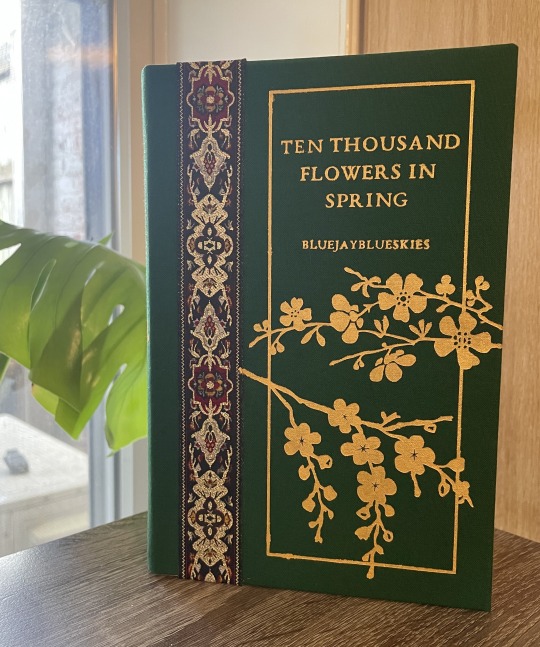
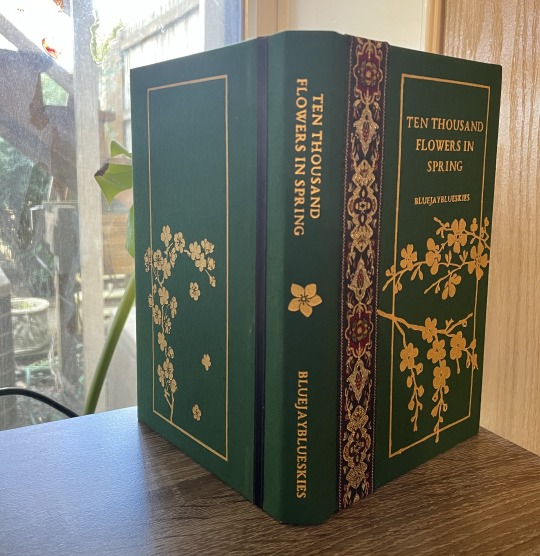
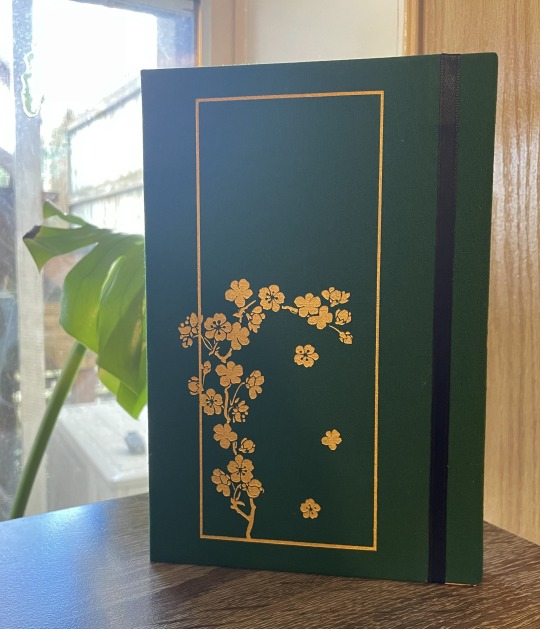
[ID: Three photos of a hand-bound book from different angles that show the front, side, and back respectively. The book has dark green bookcloth, a decorative red and gold ribbon along the front cover and a black ribbon along the back cover, and a gold painted cherry blossom design on the front and back covers. The title and author name are also in gold on the front cover and spine and read, "Ten Thousand Flowers in Spring" and "bluejayblueskies." /End ID]
Last November, I got a Silhouette cutting machine for Black Friday. This weekend, I finally got the chance to use it for a bookbinding project! I bound my fic ten thousand flowers in spring as part of one of my Fandom Trumps Hate typesetting gifts, and I had a lot of fun going all-out with the flower iconography.
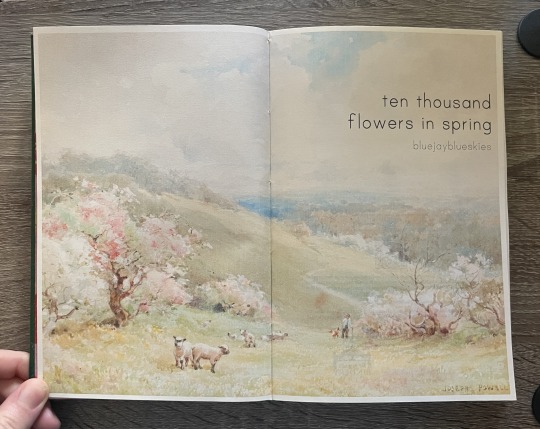
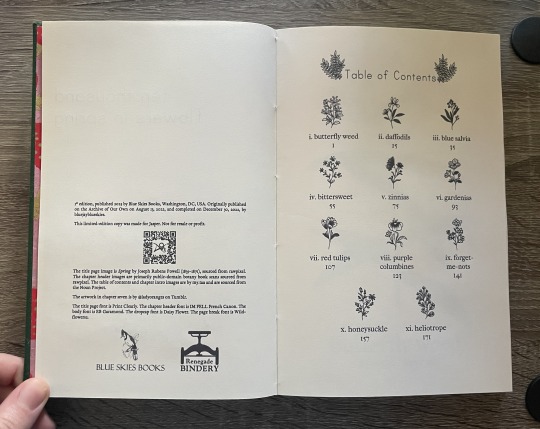
[ID: Two photos of the interior of the book. The first is the title page spread of the book, showing a pastel-colored painting of a cherry blossom-scattered hill with sheep and a shepherd that spans both pages. On the right page, there is the title "Ten Thousand Flowers in Spring" and the author name "bluejayblueskies" in a sans serif font. The second is the colophon (left) and table of contents (right) of the book. The colophon has details about the binder, the original fic, and the fonts and image sources used in the book. The table of contents has each chapter title and corresponding page number listed in a grid format with flower icons above each chapter title. /End ID]
Each chapter is titled after a flower that has a specific meaning that ties into the chapter content. I decided to style this bind after old botany books. Along with the cover, which is inspired by the covers of old botany books, each chapter header has an image of the titular flower pulled from public domain botany book scans, along with the flower's name and meaning below it.

[ID: The inside of the book, showing a page of text on the left and the chapter header on the right. The chapter header has an old-style image of blue salvia on it, with the name "blue salvia" and the meaning "friendship, family, thoughtful gestures, thinking of you" beneath it. /End ID]
Each chapter also begins with a faux-excerpt from the book Jon is writing throughout the fic:
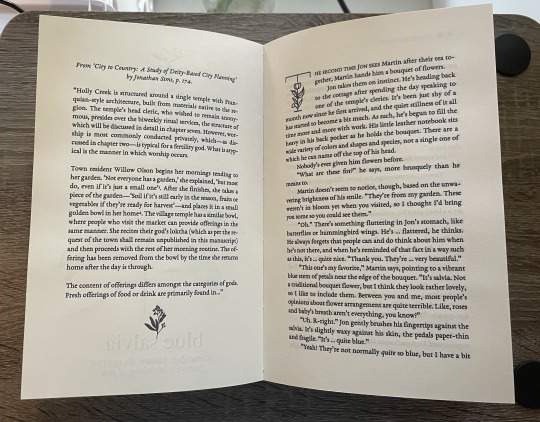
[ID: The inside of the book, showing the introductory faux book excerpt on the left and the beginning chapter text on the right. The faux book text has an image of a flower beneath it; the beginning chapter text has a drop cap with a floral design at the beginning of it. /End ID]
Some more notes and pictures on process are below the cut!
The binding style of this fic is sewn boards binding, which I like for thinner books as the spine is much less fiddly to work with. It's also a really nice binding style in general because it eliminates my least-favorite part of the binding process: casing in. When casing in a regular case-bound book, you construct the entire case separately from the text block and then attach the case to the text block via the endpapers. Inevitably, I always end up just a little bit crooked, and because my brain currently refuses to let me try using paste instead of PVA, it's very hard to fix once the endpapers are pasted down.
With sewn boards binding, the boards are attached to the text block via an extra signature of folded cardstock on the ends of the text block. The case is then constructed directly onto the text block, and glueing the endpapers down is very, very easy and near-impossible to mess up.
The ends of the boards do end up exposed with this binding style. The first time I did it, I covered them with paper. This time, I painted them gold to match the cover:
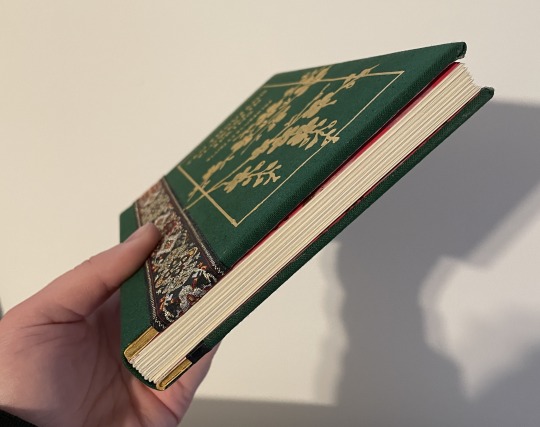
[ID: A side view of the book, showing off the exposed boards near the spine which are painted gold. The front cover of the book can also be seen at an angle. /End ID]
I plan to experiment more in the future with potentially adding endbands to this binding style, as that's one thing I wish this book had that it does not.
For the cover design, I first cut out the stencils using my Silhouette:
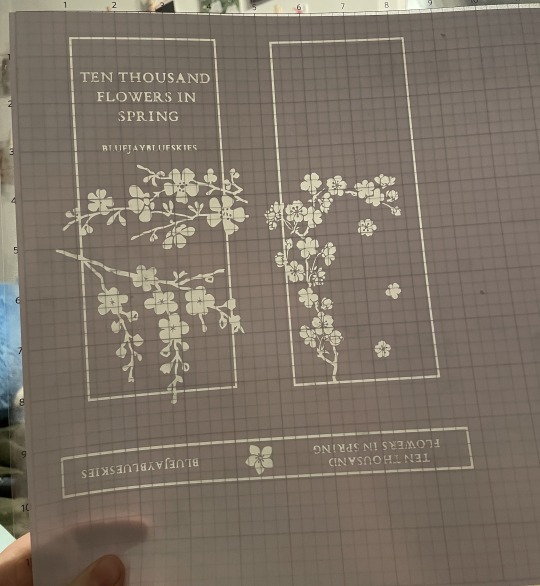
[ID: A cutting mat with white vinyl stuck to it that has been cut and weeded to expose the backlit cherry blossom design. The title "Ten Thousand Flowers in Spring" and author name "bluejayblueskies" can be seen in the designs for the front cover and spine. /End ID]
I'd heard a lot of things about weeding, positive and negative, but I actually enjoyed doing the weeding on this 😂 it was like doing a puzzle in a way. I think I would like it less if I had to keep all of the tiny little pieces and make sure they looked nice, but as it was, all I had to do was remove them and it didn't matter if they got bent in the process.
The fabric paint I have dries very quickly, so I got very little bleed on my stencil and was able to remove it almost right away:

[ID: The back cover of the book with the vinyl stencil stuck to it, painted over somewhat messily with gold fabric paint. /End ID]
Overall, I was very happy with the stenciling process and will probably continue to do stencils as opposed to heat transfer vinyl unless I want to do some bigger, blockier designs in the future.
347 notes
·
View notes
Text

Our Emotional Pains

Navigation: Masterlist✦Ask Rules✦Feedback Tips
Askbox✦Sources[23]✦Paid Readings

The moon in our natal chart represents our most emotional aspect and the potential pains it may endure, often influenced by childhood experiences. Remember that each individual is unique, and not all aspects listed here may apply to you due to various reasons. However, some tendencies are more likely to occur.
If you experience emotional pain in any area, seeking professional help from a psychologist, therapist, or acupuncturist is recommended. The moon encourages us to seek assistance from others without fear. Additionally, you can find steps to improve self-esteem in my series of posts "here." Always prioritize self-care.
ಇ. Moon in the 1st House: People with the Moon in the 1st house find their emotional identity deeply intertwined with their self-image. They may feel dependent on others' emotional validation to feel good about themselves, regardless of financial status or intelligence. Emotionally, they may experience fluctuations based on how they are perceived by others. To improve, they should focus on inner strength, firm spiritual practices, and being more self-directed.
ಇ. Moon in the 2nd House: For those with the Moon in the 2nd house, emotional security is closely tied to their financial stability. They might feel profoundly affected by financial losses, experiencing emotional turbulence when facing economic challenges. To alleviate this, they need to understand that their worth isn't solely tied to material possessions and recognize that they are supported by the abundance of the universe.
ಇ. Moon in the 3rd House: Individuals with the Moon in the 3rd house have an emotional charge connected to their thoughts and areas of learning, such as education and communication. They may have learned to suppress or avoid their feelings, leading to toxic ways of dealing with emotions. To find balance, they should embrace a healthy approach to feelings and consider seeking support from self-help books or therapeutic resources.
ಇ. Moon in the 4th House: With the Moon in the 4th house, emotional ties to family are strong and may sometimes lead to giving excessive control over one's life to family members. They might have a deep love for their family, even covering up negative emotions stemming from past experiences. Seeking therapy to address buried emotional pain from the past can be essential for their growth.
ಇ. Moon in the 5th House: Individuals with the Moon in the 5th house have a profound emotional connection to children and, if they are mothers, may feel a strong sense of responsibility. Their relationship with their own mother significantly impacts their mothering style, and they may try to compensate for any deficiencies they experienced in their maternal relationship. Therapy can help them work through these complex emotional dynamics.
ಇ. Moon in the 6th House: Those with the Moon in the 6th house feel emotionally connected to their job and might become overly absorbed in it. Imbalances in work-life can manifest physically, often causing digestive issues or stomach discomfort. Learning to set boundaries between your job and personal life and finding emotional fulfillment outside of work is crucial.
ಇ. Moon in the 7th House: Emotionally, people with the Moon in the 7th house find support and security through relationships, which can sometimes lead to dependency on their partners. They may place a lot of emotional responsibility on others, neglecting their own emotional needs. To cultivate healthier relationships, they need to take personal responsibility for their emotions and maintain a sense of individuality within partnerships.
ಇ. Moon in the 8th House: Individuals with the Moon in the 8th house have deep emotional issues tied to their family, particularly their mother. They may have experienced early traumatic events that exposed them to life's darker aspects, leading them to explore taboo or hidden subjects. Self-awareness and self-knowledge are crucial in recognizing and accepting their inner truths.
ಇ. Moon in the 9th House: For those with the Moon in the 9th house, emotional support comes from their philosophical beliefs and convictions. They may have emotional ties to their educational experiences, which can lead to revisiting themes from the past. The relationship with their mother might be seen as wise and influential, but it can also burden them with heavy expectations.
ಇ. Moon in the 10th House: Emotionally, individuals with the Moon in the 10th house are deeply connected to their career and may feel emotionally vulnerable to criticism of their work. They seek to be seen as nurturing figures in their professional roles. Finding emotional fulfillment in their life's mission and recognizing their value beyond their work can be transformative.
ಇ. Moon in the 11th House: People with the Moon in the 11th house place great importance on friendships, seeking emotional support and acceptance from their social circle. They may struggle with feelings of pain and rejection when their need for acceptance isn't met. To build healthier relationships, they need to be authentic and avoid wearing masks to please others.
ಇ. Moon in the 12th House: Individuals with the Moon in the 12th house are highly sensitive to the pain of others, often absorbing emotions from those around them. They may feel guilty for actions that weren't their responsibility. Emotionally, they have a deep desire to protect others and may have experienced emotional entanglements with their mother. Learning to establish emotional boundaries and finding healthy coping mechanisms is vital to their well-being.

The Healing Process
To heal your moon you need to learn to deal with your past, instincts and emotions and this is done with the energy of your sign, the general energy of this healing is:
ಇ. Aries: courage, leadership, drive, motivation to start projects and move forward, even with obstacles.
ಇ. Taurus: care, affection, patience to observe, see it grow, follow its own development process and the growth of others.
ಇ. Gemini: communication, the good word, the kindness, the diplomacy to make contacts, transmit information and exchange opinions with people.
ಇ. Cancer: love, intimacy, protection, warmth and emotional support to feel loved and safe, participating in a family.
ಇ. Leo: joy, spontaneity, vanity, self-esteem so that we can continue to act correctly and be proud of ourselves.
ಇ. Virgo: productivity, love of work, the desire to be useful, to serve, to help ourselves and others.
ಇ. Libra: commitment, bond, engagement with others, sophistication, love of the arts and the delicacy that enchants and captivates the people around.
ಇ. Scorpio: silence, the depth, the mystery, the emotions, the possibility of divesting us and transforming us into better people.
ಇ. Sagittarius: hope, faith in the future, positive energy, interest in going much further to discover that the world is bigger.
ಇ. Capricorn: responsibility, discipline, ethics, wisdom obtained by age, respect for the elderly, willpower.
ಇ. Aquarius: friendship, fraternity, originality, innovation, respect for differences, unconditional love for human beings and nature.
ಇ. Pisces: faith, the connection with a higher dimension, simplicity, detachment, surrender to life.
(CC) AstroJulia Some Rights Reserved

#astrojulia#astrology#witchblr#astroblr#all about astrology#astro community#astro observations#astrology notes#witch community#natal chart#birth chart#moon#aries moon#taurus moon#gemini moon#cancer moon#leo moon#libra moon#virgo moon#scorpio moon#sagittarius moon#capricorn moon#aquarius moon#pisces moon#1st house#2nd house#3rd house#4th house#5th house#6th house
562 notes
·
View notes
Text
Krang Will Rise
I have a couple theories, regarding the Krang.
There is such little evidence for it, that I don’t even think there’s evidence against it. But hear me out.
I think only Krang prime can abolish mystics. It’s not an ability tied to every Krang, only to him.
Thé Krang value strength above all else, putting no remorse into losing those deemed weak. As such, wouldn’t that make Krang Prime, their leader, the strongest? And what better way to deem yourself the strongest than carrying a unique ability that takes away your enemies greatest potential threat.
Another reason: it seems there are three types of krang. The biotech, the warrior, and the interrogator. I’m not sure how much they overlap, but I do think they carry specialities. Given krang brother is most often asked to- spread their krangness. He is responsible for krangification, domain expansion, and manipulating the technology they have (Nevermind how all these abilities make him the perfect match for Donnie)(also think Krang Brother is mute). Krang sister is the most skilled and best fighter. I’m sure she outclasses the boys in that regard. I’d go as far to say she’s second in command, leading the charge while brother krang stays behind (her role as commander matches as Commander O’Niels opposite in war, hence their quarrel). Leaving Krang Prime, who has the ability to dig into a persons mind, manipulate their captives, control the hive mind, and abolish mystic powers. Perhaps rare amongst Krang, this makes them the perfect leader (do I even need to explain why he’s Leo’s main antagonist, his opposite in every way?).
I mentioned how krang brother is likely responsible for krangification, which leads me to a second point. Clearly, from the start of the invasion to the end in the bad timeline, the krangs numbers increased 100 fold. From 3 lone survivors to hundreds if not more. Which has led me to wonder how krang are created. I have two theories: 1) in the bad timeline, the krang in the prison dimension didn’t die. Meaning that when Leo grabbed the key in the movie, and altered time, the resulting explosion caused the krang to be wiped out. 2) the probably more likely one- they repopulated.
Thé krang are clearly parasitic creatures. Meaning their reproduction is likely from a source, that source being humans. “Recreating this world in the image of krang.” Krang possession is simple, and any krang can do it, latch a bit of themselves to a human and start the battle of wills. Krang dogs are amother easier way to make more, a quick process that mangles the hosts body. We see this happen with the foot clan. But if you want powerful krang, with no chance to turn on you, and to truly become one with krang, you transform them.
Raph was found in a bubble. In a slimy krang cocoon stuck to the ceiling and filled with glowing yellow goop. He was going to be turned, transformed into Krang. And he was going to be powerful, his source material being stronger than most. He was- until the process was interrupted. Notice how the krangification didn’t come from the outside, it wasn’t attached, it was growing inside him. And, unlike the other krangified peoples we saw, his eye turned purple. It wasn’t just covered in hoop with the yellow hive mind eye, it was purple. Let it be a testament to Raphs inner strength cause he very well may have accomplished a feat deemed impossible to overcome. The process wasn’t supposed to be reversible, he wasn’t supposed to be able to break free, he was krang now. Krang Prime could feel his struggle, sense his resistance, and hear his thoughts as the turtle fought it off.
Once you turned, there was no going back. You were krang. Your old life didn’t matter. Your old friends didn’t matter. You had a new family. A new purpose to fulfill. New powers to explore. And given treasures for the hunt. The mark of a krang and a fucking massive piece of armor. This way of reproduction was useful when hunting new prey, as their knowledge of the species past through, truly allowing them to know their enemies and conquer planets. Krang can never die.
Then again. I could be wrong.
——————
Thanks for reading! Likes and Reblogs appreciated! Other related theories and stories:
Resistance to Krang; The Shredder armor; Emperym Life Blood
#wabbystuffpost#rottmnt analysis#rottmnt theory#krang#krang 1#rottmnt krang#krang raph#krang 2#krang 3#krang prime#krang brother#krang sister#krangified#Krang will rise#this gives me an idea#anyho#future timeline#bad timeline#commander o'neil#but that’s just a theory
1K notes
·
View notes
Text
Hey Tennessee fandom people: the ELVIS Act getting ready to go through. It prevents you from using likenesses of Public Figures and their voices. It's Supposed to target AI of musicians and actors but it's written So Broadly that it can effect things like Political News Reporting, Political Parody, AMVs, Fan Edits, and of course Fan Art. It's not limited to Tennessee households either so a Hollywood company can relocate a headquarters or branch to Tennessee and use Tennessee law to sue people outside the state.
If you care about any of that, then look up your county's/district's representatives in the Tennessee Senate and House and start calling. It's headed to General Assembly.
Specifically the bill says - no one can use a famous person's likeness or voice without that actor's permission for the actors life plus 10 years - .
You can see how likeness and voice can be broadly applied and of course fans would never be able to get permission for fan content.
Surely you can see how this would affect amvs and fan edits on places like Instagram.
It would also affect things like Fan Art for Live Action Series.
This would limit free use for things like parody which would effect comedy too.
It's named after Elvis and claims to be for the entertainment industry but it's written so broadly so that it can be used by public figures in general. So Politicians would be covered under it.
Honestly politicians are trying to get this passed in Tennessee to limit the use of their own likenesses for things like memes because it's a fairly easy state to get ultra conservative bullshit passed.
Here's some more info from Real Clear Policy writer Hannah Cox:
"
Right of publicity laws typically include stringent, clear exceptions and only apply to advertising, merchandise, and fundraising purposes. Those exceptions are for “newsworthy” images in content that provides a “public interest,” which encompasses everything from hard news to documentaries, to satire, to celebrity gossip.
This is a fantastic structure that ensures an individual has a right to their own personhood while also upholding the First Amendment, its protections for free expression and freedom of the press, and ensuring the public has easy, fast access to information.
The ELVIS Act doesn’t include these provisions. As currently written, filmmakers would have to obtain permission from nefarious actors like Jeffrey Epstein’s estate in order to make a documentary about him. The producers of Forrest Gump wouldn’t be able to include all those scenes with historic figures.
That’s a really good way to protect powerful people from scrutiny. And it would severely stagnate the flow of information online as even obtaining such permissions could take weeks. Additionally, out of fear, many content creators would simply play it safe out of fear of litigation.
The ELVIS Act also does not limit its reach to those living or dead, nor does it restrict its parameters to those with a Tennessee domicile. This seems like an open plea for people to infiltrate the state with ridiculous lawsuits that wouldn’t make it past the first gate elsewhere. It’s almost like the trial lawyers associations wrote this bill instead of Hollywood unions.
But to be clear, this was brought to the Republican legislature by the music industry associations and Hollywood unions - a peculiar entity for conservative lawmakers to be carrying water for to say the least. What these entities really want is an end to Fair Use practices because they’re bleeding money, and instead of making better products or creating new revenue sources, they’re simply being lazy and attempting to restrict the market.
"
--
When you call: You're a concerned republican worried about how limiting AI can hurt small business and how the law should be written more specifically and Exceptions Should be included To Protect Fair Use for Non-Commercial, News, and Parody use, because all are integral to Free Speech.
The Law is Simply Too Broad the way that it's written now and it limits Facebook campaign support for Republicans if they have to get permission from Liberals to use their likenesses. It limits free speech which is integral to preaching God's good word against his disbelievers in a political setting and you won't stand by a politician that limits your freedoms like that. This is America Land of the Free and you'll be damned if you let someone step on you like that. That its Big Government infringing on your rights as an American instead of sensible small government.
--
If you dont live in Tennesse this will still affect you with the ways it's written. It doesn't take much for companies to set up "official" shop in a new state.
It will also ABSOLUTELY be used as the model for a much worse NATIONAL bill if it gets passed in Tennessee. Because Politicians will see that it already succeeded once and HollyWood and the Music Industry are two lobbies FLUSH with cash for bribes and campaign donations.
Mark my words this will absolutely bleed over into national politics which will be devastating for News Reporting and informing the populace which is ALREADY in awful shape.
#Tennessee#ELVIS Act#Jesus christ we're getting jumped from every fucking direction. this year is fucking terrible#KOSA#stop kosa#stop csam
140 notes
·
View notes
Text
“Roaming into immortality”: Ten Desires and the history of Taoist immortals

As promised last month, following the freshly established tradition I have another Touhou research post to offer. This time, we’ll be looking into the literary traditions focused on Taoist immortals (or, following the Touhou convention, “hermits”, though this is a less suitable translation) and how they influenced Ten Desires. Due to space constraints and thematic coherence, note that only Seiga, Miko and Yoshika will be covered.
Before you'll begin, I need to stress that one of the sections requires a content warning. While all images are safe for viewing, there's a description of a potentially unpleasant episode involving unwanted advances, and various events leading to that; I highlighted that before the relevant paragraphs too just in case.
“Hermit”, “immortal”, “transcendent”
A post about Ten Desires must start with an introduction of the term sen, the Japanese reading of 仙, Chinese xian. Touhou specifically uses its less common derivative 仙人, sennin, though that's just a synonym. Touhou-related sources basically invariably translate this term as “hermit”. While this option can be found elsewhere too, it is not exactly optimal.
“Immortal” is actually the standard translation for both sen/xian and sennin, as far as I am aware. I did a quick survey of recent publications on Brill’s and De Gruyter’s sites and the results were fairly unambiguous, especially for books and articles published after 2000, with “hermit”, “wizard” and other alternatives being quite uncommon. The trend is not new, with sennin already translated as “immortal” in the 1960s.
When it comes to xian/sen, in a few cases arguments were made that “transcendent” or “ascendent” would be a more suitable option as it better illustrates the position of these beings, though this is a relatively recent trend, for now limited to Sinology. The idea behind it is that immortality is just one of multiple characteristics attributed to the xian, and it is ultimately the transcendence to a higher level of existence that’s the key element. I personally think the argument is sound, but not all translators have embraced it, and for now the choice is really a matter of preference. Since “immortal” is more widespread, and most of the sources in the bibliography use it, that’s what I will employ in the rest of the article, save for direct quotes from Touhou, where "hermit" will be used.
Early history of immortality in Chinese sources
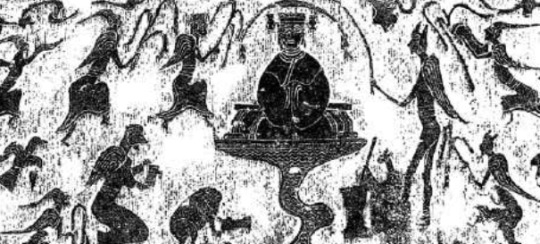
Feathered immortals worshiping Xi Wangmu (from Betwixt and Between: Depictions of Immortals in Eastern Han Dynasty Tomb Reliefs by Leslie Wallace; reproduced here for educational purposes only)
The notion of pursuit of immortality, or at least longevity, is first attested in Chinese sources in the eighth century BCE, when the first bronze inscriptions revealing their authors wished to avoid death altogether appear in the archaeological record. However, the ideas which directly lead to the development of the concept of immortals as discussed here only started to develop in the fourth BCE. Initially they were associated with so-called fangshi, a class of multi-purpose esoteric specialists who often served for example as court diviners.
These ideas developed before the unification of China by Qin Shi Huang, but their importance grew after this event, as many of their proponents were warmly received in the courts of Qin and Han emperors. Some of them, like Wu of Han, even sent expeditions in search of distant lands where immortals purportedly lived, of which Penglai is the most famous.
As a curiosity it’s worth mentioning here that the reception of these pursuits was actually mixed in Chinese historiography. Some of the rationalist Eastern Han authors such as Wang Chong evaluated it critically, basically describing it as a waste of time and resources leading to poor governance.
We know relatively little about the development of beliefs focused on immortality outside of the imperial court in the Han period, though it is evident that they gained considerable prominence, and it’s even possible to speak of “immortality cults” among the general populace. That’s for example seemingly how the worship of Xi Wangmu, arguably one of the most famous Chinese deities, became widespread. Tomb paintings showing blissful immortals also appear in this period.
In art immortals were initially depicted as winged, feathered beings. The origin of this tradition remains unclear, though it has been noted that various similar bird-like beings are also listed in the Classic of Mountains and Seas, attesting to this being a widespread motif in early Chinese tradition. You might be familiar with portraying immortals as wizened sages instead. This convention only developed when the image of the immortal merged with that of the ascetic hermit in the Eastern Jin period - more on that later.
Immortals in Ge Hong’s Baopuzi

A 20th century illustration of Ge Hong (wikimedia commons)
The first formalized instructions for the pursuit of immortality were compiled during the reign of the Eastern Han. Some of them were rooted in the early Taoist tradition, which at the time was also being partially formalized under the Way of the Celestial Masters. Seemingly many Taoist works dealing with these matters were compiled, but most of them are only known from references in Ge Hong’s Baopuzi, one of the most important texts for the study of the history of ideas about immortality.
Ge Hong states that immortality can be obtained through personal virtue and specific practices, including exercise, following strict dietary restrictions and, most importantly, through engaging in alchemy, which he hails as the most effective. All the means to obtaining immortality were unified by one principle: cultivating qi, both by maintaining one’s own and by absorbing it from the right kinds of plants and minerals. Grains were held to be inappropriate food for those pursuing immortality, as it was believed they nourished the so-called “three worms”. The final goal was to be able to use morning dew or light for sustenance. The easiest way to move towards that goal was believed to be consumption of alchemical elixirs, said to possess a more potent, refined form of qi of all their carefully selected ingredients.
Needless to say, many of such magical concoctions were highly poisonous thanks to the inclusion of mercury, cinnabar and other similarly exciting substances. Ten Desires describes the consequences pretty accurately: Miko “turned to the use of various unusual materials, such as cinnabar” which “ruined her body”; as a result she “destroyed her health because of the very Taoism that was meant to grant her immortality”. Such a fate is not historically unparalleled, and there is even a strong case to be made that the notoriously erratic behavior of some of the particularly immortality-obsessed emperors was the result of alchemically induced heavy metal poisoning.
Cinnabar cocktails aside, a further important piece of information from Baopuzi is the reference to three classes of immortals, celestial (天仙), earthbound (地仙) and corpse-liberated (尸解仙). What separated these three groups was the degree to which they perfected their state before formally attaining the rank of immortal. The most refined were basically invited into heaven, with the best of the best taken there on the back of a dragon. Those who despite their efforts lacked something had to put in some additional effort themselves instead.
While the "celestial" and "earthbound" immortals are largely self-explanatory (we'll go back to them later, though), the label of “corpse-liberated” warrants a more detailed explanation. It refers to those who settled for faking own death. This act is called shijie (尸解), and involves substituting the body for an object, which is to be buried as if it was a person. Of course, immortality obtained this way was effectively second rate, though it was not impossible to become a proper celestial immortal later on. As you can probably notice, this is precisely the path to immortality ZUN has chosen for characters in Ten Desires. The term shikaisen used multiple times in the game is in fact simply the Japanese reading of 尸解仙.
Immortals in secular literature

Four Immortals Saluting Longevity by Shang Xi (wikimedia commons)
The importance of the search for immortality grew during the Six Dynasties period. Seemingly in all strata of society a common reaction to frequent political turmoil was to seek solutions in Taoism and still relatively new Buddhism. This in turn left a huge impact on Chinese culture of this era as a whole.
What is of particular relevance for this article is less the straightforward religious dimension of immortality, and more its reflection in literature. Works about immortals were already being written in the Western Han period, with the oldest surviving example being Liexian Zhuan (列仙傳) attributed to Liu Xiang, who lived in the first century BCE. Their importance only grew with time due to the aforementioned process, and they became a well established part of both poetry and prose. For example, a sixth century treatise on literary genres, Xiao Tong’s Selections of Refined Literature (文選; Wenxuan), pretty much the main source to fall back on in the study of pre-Tang literature, recognizes youxian (遊仙), literally “roaming into immortality”, as a distinct type of lyrical poetry. There’s a considerably degree of nuance to this term, since 遊 has the implications of leisurely, playful activity, but these lexical considerations are beyond the scope of this article.
While in some cases the tales of immortals focused on figures primarily known for other reasons, like the Yellow Emperor, Chang'e or Laozi, many document the lives of historical pursuers of immortality instead. Well attested fangshi and Taoist masters appear in such a context, for instance Anqi Sheng or Liu An (according to a legend he ascended to heaven with his entire household, including dogs and other animals).
The literary biographies, or rather hagiographies, of immortals often highlighted their personal eccentricities, tied to their detachment from society. The archetypal eccentric immortals are obviously the members of the group popularly known as the Eight Immortals, though this is a much later development, and the genre conventions formed centuries earlier.
Literature about immortals is interesting from a modern perspective because at least in part it was arguably a secular pursuit. As secular as something could be prior to the rise of the modern notion of secularism, that is (see Mark Teeuwen’s article on Edo period secularism for some arguments against seeing secularism as an entirely modern phenomenon). This is not merely the modern perception, for clarity - the earliest statements to that effect can be found in works of literary criticism from the second century or so. The writers were chiefly scholars, courtiers and officials, not clergy, and naturally their works are not recognized as “canonical” Taoist literature.
Some of these authors took the topic of immortals into rather peculiar directions. According to Xiaofei Kang, during the Six Dynasties period amorous encounters with female immortals (仙女, xiannü) were a “fashionable topic among literati”, while in the subsequent Tang period some authors compared courtesans they sometimes were actually involved with to immortals metaphorically. She notes that they effectively created a genre of works focused on immortals which was no longer really describing the pursuit of immortality, but rather “encounters with enchanting beauties, both real and imagined”.
Needless to say, the literature about immortals remained relevant in later periods, and new stories continued to be written under the reign of subsequent dynasties. Many can be found in Pu Songling’s famous Liaozhai (Strange Tales from a Chinese Studio). This collection was written in the Qing period and remains in wide circulation today as a literary classic.
Pu Songling’s tale of Qing’e: the origin of Seiga
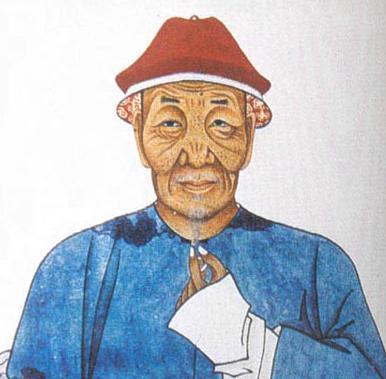
Pu Songling (wikimedia commons)
It is beyond the scope of this article to discuss all of Pu Songling’s tales about immortals, but there is one which necessitates further discussion, namely Qing’e, which is very obviously the basis for Seiga’s character. This makes her somewhat unusual among Touhou characters - while the story she is based on deals with religious themes, and fiction can shape religious views at times (as evidenced by the popularity of Sun Wukong or the image of hell in Divine Comedy), I found no indication Qing’e was ever views as anything but a literary character.
Like the rest of Liaozhai, the Qing’e tale has been translated into English in the 2000s. Songling’s works have an older and more famous translation too, but it’s just a selection, and it has many issues, which you can read about here. You can read parts of the more modern translation on Google Books. Obviously it can also be found easily in other places. I will also summarize the story of Qing’e below for convenience.
This is where the content warning I mentioned applies: the story is not very explicit, but there are is a scene of what I think counts as attempted sexual assault and other generally unsavory moments of that sort, so if that bothers you, skip ahead to the next section.
The beginning of the story introduces a certain Huo Huan (霍桓) from Shanxi, a sheltered young man of unspecified age (he’s older than 13 but “ignorant of adult desire”, which is pretty vague). He lives in the same neighborhood as the eponymous Qing’e (青娥), a teenage daughter of a certain mr. Wu (武), who was apparently a devout Taoist. Qing’e secretly read through her father’s personal collection, developing an admiration for He Xiangu in the process. When mr. Wu left for the mountains to become an immortal, his daughter declared she will never marry. Her decision is presumably meant to mirror one of the versions of the tale of He Xiangnu, who reportedly attained immortality by remaining celibate and consuming mineral powders (granted, you can also find versions where her immortal career started when she was seduced by Lü Dongbin, but that does not match the story here).
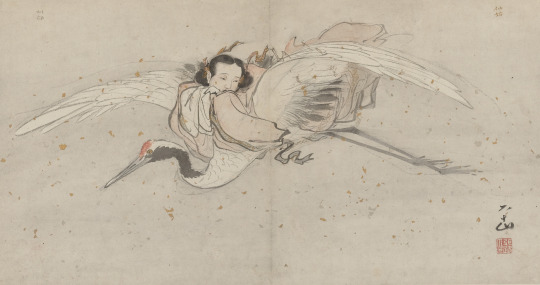
He Xiangnu by Zhang Lu (wikimedia commons)
Huan sees Qing’e outside at some point and, without really talking to her, decides she has to marry her and asks his mother to send someone to arrange that. she doesn’t think it’s a good idea, but eventually caves in. Lo and behold, it doesn’t work and the Wu family is not interested in the proposal. Huan then meets an unrelated Taoist, who offers him a magical tiny spade (one chi long) used to dig up Taoist-preferred herbs (a key component of the immortality keto diet), which can quite literally hack through stone. This convenient deus ex machina gives Huo the idea to hack through the walls of the Wu residence to see Qing’e. Note that the narrator does not approve of this plan, and calls it an “illegal act”. Alas, it comes to pass anyway,
With this newfound power Huan watches Qing’e undress before she goes to bed and then listens to her breathing while she is asleep, as one does with women they saw exactly once before. Eventually he falls asleep himself on her bed. Needless to say, when Qing’e wakes up she is less than thrilled and summons her servants. They assume Huan is a thief, but he tries to explain himself. He’s set free, but the magical tool is confiscated.
Since Huan does not know when to quit, he arranges for a second round of matchmaking afterwards. While apparently Qing’e is cautiously optimistic about it this time, her mother is less than thrilled after learning there are now holes in their residence’s walls. She insults the matchmakers, Huan and Huan’s mother. This in turn makes Huan’s mother angry. She apparently concludes that Huan and Qing’e had sex, and declares that instead of damaging her good name someone should’ve just killed them both on the spot. Qing’e is genuinely sad about this and sends a messenger to smooth things over. However, ultimately nothing really comes out of it.
Some time later, Huan starts a career as a helper of his town’s magistrate, Ou. The latter is surprised to learn he is not married yet, and after hearing about his unsuccessful endeavors intervenes himself. With the help of other local officials he secures the permission of Qing’e’s mother, and the marriage is officially arranged.
A year later, Qing’e arrived at Huan's home. She brings the magical tool with her, and declares that it is no longer needed. However, Huan decides to carry it with him as a good luck charm, pointing out acquiring it was what led to their marriage. Some time later newlyweds have a son, Mengxian, but Qing’e is not interested in raising him and entrusts that entirely to a nurse. After some more time, in the eighth year of their marriage, she announces to Huan that their time together is coming to a close, and there is nothing to be done about this. Shortly after that, she seemingly dies, and Huan and his mother bury her - or so they think, at least.
In the aftermath of this event Huan’s mother falls sick, and inexplicably develops a craving for fish soup, which is hard to obtain in the area the story takes place according to the narrator. Huan, as a staunch believer in filial piety, decides to embark on a journey to procure some. He is initially unsuccessful, but he manages to get some from Wang, an old man he encountered in the mountains. The latter also offers to introduce him to a beautiful woman, but Huan is focused on the quest for fish soup and declines.

Contemporary Chinese fish soup (wikimedia commons)
With the power of fish soup Huan’s mother’s health is restored, and when it becomes clear she’s going to be fine he decides to seek Wang again. He does not find him, but after a long trek in the mountains he instead stumbles upon an unusual cave. Unusual because there’s a house inside it. a house which, as it turns out, is inhabited by Qing’e.
Qing’e is surprised to see Huan. She explains that she faked her death and in reality a bamboo cane was buried in her place. She concludes that if Huan found her, they are presumably fated to be together as immortals. He is then taken to her father, who as established earlier also became an immortal. The initial reception is positive, but Huan makes a scene demanding that Qing’e have sex with him and keeps clutching her arm when she declines. Qinge’s father intervenes, and kicks him out for attempted sacrilege in his hermitage.
Alas, Huan can’t get a clue as already established. He cannot see the house anymore because due to a trick there’s only a cliff in front of him after the doors close, but that’s not really enough to stop him, as he suddenly remembers he has the magical tool with him. He starts digging, and despite insults hurled at him from behind the rocks eventually makes a sizable hole in the cliff. At this point someone, presumably Qing’e’s father, gets fed up, and throws Qing’e out through the hole to get him to leave.
Qing’e, to put it lightly, is not very keen on this turn of events. She nonetheless returns with Huan to his house. Shortly after that they moved elsewhere, to Yidu, where they lived for eighteen years. Qing’e at some point gave birth to a second child, a nameless daughter, who doesn’t really factor into the story. All we hear about her is that she married into a local family.
Eventually Hano’s mother dies. Qing’e picks an auspicious location for her resting place, and tasks Huan and Mengxian with preparing the burial. A month later, she and Huan disappear, leaving the new adult Mengxian alone.
In the final scene of the story, Megxian, who apparently spent the first twenty or so years of his adult life unsuccessfully attempting to pass the imperial examination, meets a certain Zhongxian, and is amazed to learn they bear the same surname. The two quickly realize they’re brothers, and decide to meet with their parents, but they fail to accomplish that since they left Zhongxian’s house in the meanwhile.
The narrator comments that while Huan’s actions were “foolish” and “crazy”, everything he had striven for was granted to him as a reward for his filial piety, and then marvels why nobody stopped him and Qing’e from having more inevitably abandoned children. “That’s really strange,” he remarks.
Seiga’s character between ZUN’s innovations and Taoist tradition

Seiga explaining the powers of a hermit; if only there was a term which makes this explanation even more straightforward... (WaHH chapter 12.1)
As you’ve probably noticed, Seiga’s bio in the Ten Desires omake is remarkably faithful to the adapted source. Even her name is just a Japanese reading of the combination of Qing’e’s given name with the family name of her husband. It does not seem that everything unfolded identically in Touhou, though. There is no indication in the bio, or anywhere else for that matter, that Seiga went back after faking her death, and we instead learn that she decided to travel to Japan, since Taoist “hermits” were uncommon there. Additionally, Seiga presumably kept the confiscated chisel, since her ability, which she eagerly demonstrates in Wild and Horned Hermit, is rather obviously a direct reference to the tale of Qing’e. I will admit that while I do not question Pu Songling’s talent and enjoyed many of his tales, I think ZUN’s version is more satisfying than the original, perhaps because from a modern perspective Qing’e is arguably a more compelling protagonist than her husband, and Touhou effectively treats her as the main character in this story.
Something that I believe is relatively well known is that Seiga’s entire character is a bit of an anachronism: to encounter Miko, she would need to be alive through the end of the Six Dynasties period already. However, since ZUN adapted much of the tale of Qing’e directly, like her forerunner she idolizes He Xiangnu, who according to legends about her was only born in the Tang period, and attained the status of an immortal in the early eighth century, during the reign of emperor Zhongzong - nearly a century after Miko’s semi-historical counterpart passed away. I do not think this mistake is meaningful. Save for the references to He Xiangnu and imperial examinations, the tale of Qing’e is set in a largely timeless world. I would presume it’s just a small mistake on ZUN’s part, and he didn’t check the chronology while summarizing the part of the story he wanted to use in Seiga’s bio. There is no need to ponder if Seiga’s power lets her travel in time, as the wiki (which, as we all know, prides itself in maintaining “neutrality” and enforcing correct exegesis of the source material, especially Hisami’s bio) does.
There is a further aspect of Seiga’s character which might evoke works about immortals, though I am not sure if this was intentional. As we learn from her entry in Symposium of Post-Mysticism, she “cannot become a celestial due to her personality, but that does not seem to bother her”. The term dixian which I already brought up before designated immortals who were not interested in ascension to heaven. According to Ge Hong, there were actually many benefits to such a fate, and while nominally a dixian ranked below a tianxian (in Touhou terms, a celestial), they had much more freedom. He states that the archetypal immortal Peng Zu, who spent over 800 years on earth, did so because the upper echelons of the heavenly hierarchy are occupied by well established deities, and any immortal joining their ranks would be burdened with tiresome tasks and obliged to act as servants, making their life less enjoyable than it would be on earth.

Peng Zu (wikimedia commons)
Poetry describing the earthbound immortals originally developed in the third and fourth centuries. Parallels can be drawn between their protagonists who reject the celestial bureaucracy with a different class of literary characters popular at the same period - non-conformist recluses who did not care about the mundane, earthly administration. The dixian is essentially a merge between the classical supernatural immortal and the archetypal hermit. This sort of immortality was a metaphor for unrestrained freedom first and foremost.
I will stress again that I have doubts about whether ZUN was aware of this when he came up with Seiga, but it certainly does fit her well. Also, more recently, in Who’s Who of Humans and Yokai in Gensokyo he actually says that “she may be the most hermit-ish character here”. I’d hazard that even if he was not aware of this idea before, he probably is now, in some capacity at least. It’s not like Seiga’s status as a “wicked hermit” was ever tied to lack of interest in heaven, as opposed to necromancy, so this does not contradict anything established.
Reception of Chinese tales about immortals in Japan
Obviously, ZUN is not the first person in Japan to adapt literature about immortals.Something that needs to be stressed before delving deeper into the topic is that transfer of beliefs, and especially tales, pertaining to immortals to Japan did not constitute the spread of Taoism as an organized religion. It is instead simply an aspect of the widespread adoption of elements of Chinese culture. While Taoist ideas were an aspect of this phenomenon, we know relatively little about how they were transmitted to Japan, though there was clearly no effort to introduce the religion itself in a formal manner the way Buddhism was. This topic ultimately can’t be explored here in detail due to space constraints. but most likely what occurred was gradual introduction of certain elements in informal contexts: through art, Buddhist borrowings or poorly documented individual ventures.
The earliest recorded example of reception of motifs related to immortals in Japan is likely the tale of Tajimamori from the Nihon Shoki, which involves a quest for items granting immortality. The much better known tale of Urashima Taro, also preserved in this source, is another candidate, and as a matter of fact was recognized as an example of literature about immortals in the Heian period already.
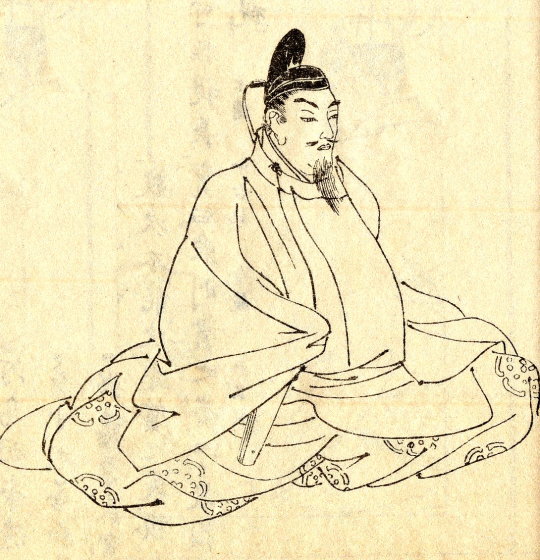
Ōe no Masafusa (wikimedia commons)
However, our main source of the early Japanese perception of immortals are not the early “national chronicles”, but rather Honchō Shinsenden (本朝神仙伝). Its author was Ōe no Masafusa (1041-1111), an official and scholar from the Heian period. His career culminated when he was appointed to the prestigious position of the governor of Kyushu, though he eventually abdicated to dedicate himself to writing. His work is classified as an example of setsuwa. At the same time it is also firmly tied to the already discussed tradition of Chinese secular immortal literature, and can effectively be considered an attempt at creating a Japanese equivalent of collections of biographies of immortals. Obviously it has its own unique peculiarities to offer too.
Masafusa’s work presents an interesting case of fusion of the Taoist-influenced Chinese notion of immortality with Buddhist ideas: the immortals are compared to hijiri (Buddhist “holy men”) and “living Buddhas” (ikibotoke). This is not entirely a novelty, as while Buddhists are absent from Chinese compilations of biographies of immortals, Laozi’s ascent to immortality was nonetheless at times described in similar terms as Buddhist Nirvana, at least in sources from the fifth century. There was also a preexisting Buddhist tradition of legendary long-lived patriarchs awaiting the coming of Maitreya or simply extending their lifespans to save more beings. Therefore, while innovative, this combination of Taoist and Buddhist elements was hardly something unparalleled or contradictory.
The selection of figures described as immortals in Honchō Shinsenden is also a bit different than in its Chinese forerunners. Legendary heroes and historical statesmen do show up, as expected. However, alchemists and members of Taoist clergy are missing, since they were not exactly common in Japan. Buddhist monks effectively replace them as the main social group among immortals, though it does not seem religious devotion is the deciding factor. Ultimately there is no clear pattern, not even that of virtuous life: Masafusa’s immortals as a group are not meant to be moral examples, even though some of them are portrayed as paragons of virtue.
It seems ultimately what Masafusa wanted to do is present stories he personally found interesting or awe-inspiring, and there was no religious aim behind his work. Some of his choices were actually criticized as inappropriate by his contemporaries, in particular the inclusions of Zenchū and Zensan, who according to polemics were not immortals, but merely devout Buddhists taken into a Pure Land (a heavenly realm created by and inhabited by a Buddha) in their current forms, without reincarnation. This argument follows the well established aspect of esoteric Buddhist doctrine, which enabled the possibility of achieving enlightenment in one’s current incarnation.
A total of thirty seven tales formed the original manuscript, though not all of them survive. They range from long, grandiose narratives about figures like Yamato Takeru and En no Gyoja to brief, almost comedic accounts of the tribulations of anonymous figures such as the “stick-beaten immortal” (who learned how to levitate, but only up to the height of one shaku, which meant that he could not even escape children hitting him with sticks) or the “old seller of white chopsticks” (whose title tells you a lot about his economic situation). Only two are ultimately important here, though: those of the semi-historical prince Shotoku, and the firmly historical poet, historian and eccentric Miyako no Yoshika.
Simply put, I believe Honchō Shinsenden is responsible both for the portrayal of Shotoku as a Taoist immortal and for the inclusion of a character (vaguely) based on Miyako no Yoshika in Ten Desires.
Honchō Shinsenden’s Shotoku and Toyosatomimi no Miko

The image of prince Shotoku through the ages
Prince Shotoku (聖徳太子) is one of the highest profile figures to ever be portrayed in Touhou, and as such arguably requires no lengthy introduction. He purportedly lived from February 7, 574 to April 8, 622, and served as a regent on behalf of his aunt, empress Suiko. He is traditionally credited with spreading Buddhism in Japan, ordaining numerous monks, writing commentaries on sutras, vanquishing rivals such as Mononobe no Moriya with the help of the Soga clan, and so on. He might have not existed at all, or perhaps he did, but played nowhere near as major of a role in Japanese history as traditionally assumed. The academic debate started a few decades ago, and remains ongoing. Its outcome isn’t really important here, since regardless of Shotoku’s disputed historicity, he came to be well established both as a religious figure and as a literary character. At various points in time and for various people, Shotoku was, in no particular order, the ideal statesman, a manifestation of Kannon, a peerless military commander, a yaoi protagonist and, most importantly, an immortal.
In Honchō Shinsenden, Shotoku is referred to as “prince Jōgu” (上宮), though we do get the mandatory Shotoku namedrop indirectly when his virtue (聖徳) is highlighted.. He is actually one of the two only of the listed immortals who can be classified at least vaguely as “statesmen”, the other being Yamato Takeru. For unknown reasons, Masafusa got some details wrong: according to him Shotoku’s father was Bidatsu. This view is unparalleled, and there is no real reason to doubt the conventional genealogy, which firmly positions him as a son of Yomei and his half-sister Anahobe no Hashihito. We learn that his birth was foretold by a dream in which his mother saw a golden figure who entrusted her with a child who will spread the dharma. This is in itself a combination of Taoist and Buddhist elements, seemingly an attempt at imitating a legend about the birth of Laozi, which in turn depended on a legend about the birth of the historical Buddha.
Naturally, Shotoku already displayed supernatural abilities as a child. Masafusa reports that whoever touched him was imbued with a “lasting fragrance”. A variant of the well known tale which his Touhou counterpart’s name and ability reference is presented here too, though a key detail differs - Shotoku can listen to eight, rather than ten, people according to Masafusa. This is not unparalleled, and therefore probably isn’t a mistake unlike the unexpected genealogical change mentioned before.
A major event from Shotoku’s life relayed by Honchō Shinsenden is an alleged meeting between him and Illa (Nichira), a Korean monk living in Japan. The historicity of this episode is debatable, as Illa died when Shotoku (if he was real in the first place, of course) was only eleven years old. He identifies the prince as the bodhisattva Kannon, and pays respect to him as such. In response Shotoku emitted a beam of light from between his eyebrows, which reflects both Taoist and Buddhist traditions about manifesting supernatural powers.

Illa's alter ego Atago Gongen (wikimedia commons)
Interestingly, Illa responds by doing the same, thus revealing his own supernatural character. We know from other sources that Illa could be identified as the true identity of Atago Gongen, the tengu-like deity of Mount Atago. Bernard Faure notes parallels can be drawn between his portrayals as a foreign supernatural ally of Shotoku and as the human alter ego of a deity with the traditions pertaining to Hata no Kawakatsu. There is also an “immortal of Mount Atago” in Honchō Shinsenden, but his identity is left unspecified. It's worth noting that in Symposium of Post-Mysticism Byakuren and Marisa at one point discuss the existence of “hermit-like tengu”. Illa truthers… we can make it happen if we believe strong enough… Jokes aside, I’m actually cautiously optimistic that Illa might some day end up being the first Korean character in Touhou, at least implicitly. Given the inclusion of references to Hata no Kawakatsu, odds are decent ZUN knows about him too.
In another anecdote, we are introduced to another member of Shotoku’s supernatural supporting cast, the black steed of Kai. This horse is credited with being able to travel the distance of a thousand ri in a single move. This is seemingly an adaptation of a Taoist motif too, as immortals were believed to favor traveling on supernaturally fast steeds, or in cloud chariots drawn by such animals, or to move instantaneously through other means. The fabulous distance of 1000 (or even 10000) ri is conventional, too.
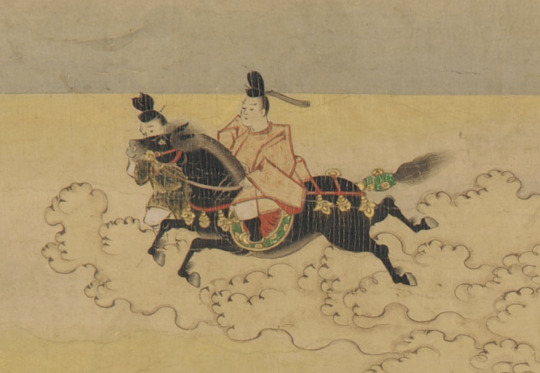
Shotoku traveling through the sky on his supernatural horse (Smithsonian Institution; reproduced here for educational purposes only)
Of course, the black steed (kurokoma) is also the very same horse that served as the basis for Saki. While allusions to this connection is probably the second most common genre of fanart of her, it surprisingly took ZUN four whole years to acknowledge it outside of a track title, specifically through two lines in the vs mode of Unlimited Dream of All Living Ghost. Time will tell if anything will come out of it, I’m personally skeptical seeing as we have yet to see a canon work do anything with the connection between Okina and Hata no Kawakatsu even though it was acknowledged in an interview. I hope I am wrong, though.
Shotoku’s various accomplishments are not described in detail, though Masafusa does bring up his famous seventeen articles constitution and the establishment of Shitenno-ji, and additionally states that teachings linked to the Yuezhi people from Central Asia were associated with it (unique opportunity to justify bringing Central Asian deities like Nana and Weshparkar into Touhou).
The final and most important part of Shotoku’s biography, the circumstances of his death - or rather his acquisition of immortality - is only partially preserved. According to Masafusa, one day he simply informed his wife (presumably Kawashide no Iratsume, as opposed to one of the other three wives) that he cannot exist anymore in a “defiled” world and “transformed” himself. It is actually not explained how he even mastered the techniques allowing that, presumably because we are meant to attribute this miraculous feat to his status as a saintly Buddhist. The authors behind the most recent English translation, Christoph Kleine and Livia Kohn, suggest that in the lost final sentence(s) Masafusa might have combined the Taoist take on immortality with Amida’s pure land, but this is ultimately speculative.
ZUN actually went for something closer to the Chinese model with Miko - she was explicitly taught by Seiga. The notion of immortals mentoring those they deem worthy to pursue the same path is a widespread motif, and even some of the Eight Immortals gained their status this way. This idea is absent altogether from Honchō Shinsenden, perhaps since it was tied to formal transfer of Taoist teachings. While this is an innovation, I would argue it’s still true to Shotoku legends, considering they are already filled with miracle-working visitors from distant lands, from Illa and Hata no Kawakatsu to considerably more famous Bodhidharma.
From eccentric to immortal: the literary afterlife of Miyako no Yoshika

Miyako no Yoshika (wikimedia commons)
As I already said, the second tale from Honchō Shinsenden relevant to Ten Desires is that focused on Miyako no Yoshika. He obviously shares no direct connection with prince Shotoku. Or with Qing’e, for that matter. Unlike prince Shotoku, he left a solid paper trail behind, and there’s no doubt that despite having quite a career as a legendary figure, he was originally a historical person. He lived from 834 to 879, in the Heian period. He was a calligrapher, a poet, an imperial official and for a brief time even an assistant to the envoy to Bohai (Balhae). The inclusion of a character based on him in Ten Desires might seem puzzling at first glance, since none of this seems particularly relevant to the game, and Yoshika’s omake bio doesn’t say much that helps here, beyond calling her a “corpse from ancient Japan”. However, I believe Honchō Shinsenden sheds some light on this mystery.
In Honchō Shinsenden, Miyako no Yoshika belongs to the small category of literati pursuing immortality, a status he only shares with Tachibana no Masamichi. There are a number of other immortals listed who are neither monks nor statesmen, and can be broadly classified as laypeople, though none of them seem to have much to do with those two. In contrast with figures like prince Shotoku, described as pious sages, the fictionalized take on Yoshika is meant to highlight extreme eccentricity instead. This is an element common in accounts of Chinese immortals’ lives too, as I highlighted before. You might also remember this topic from the Zanmu article from last month.
As we learn, Yoshika, who was originally known as Kuwahara (misread by Masafusa as Haraaka, an actually unattested surname) no Kotomichi but changed first his family name (for unknown reasons) and then also his given name because of a poem he liked, decided to become an immortal under rather unusual circumstances. In the very beginning of his career, after spending a night with the concubine of an official from the Bureau of Examination who was meant to examine him the next day, Yoshika decided that his goal in life should be to become an “eccentric immortal”. He passed his official exam without any trouble, with an unparalleled score. Graffiti in the academy he attended proclaimed him the “world’s greatest maniac” (so he comes prepackaged with a Touhou-appropriate title). He attained widespread acclaim for his wit and poetic skill. In his free time, he engages in celebrated literati pastimes such as drinking and sleeping with courtesans (Masafusa does not specify if he wrote about that, like his Tang counterparts did).
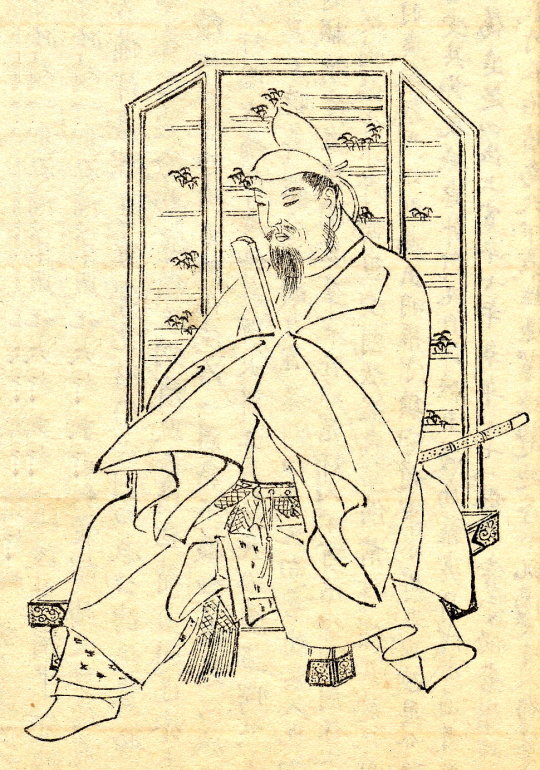
Sugawara no Michizane, Yoshika's apparent nemesis (wikimedia commons)
Alas, Yoshika’s career ultimately did not go entirely according to his whims. The beginning of the end was the day when he acted as the examiner of a new rising star, Sugawa no Michizane. The latter has proven himself to be even more skilled than him, and eventually rose to a higher rank than Yoshika. The latter could not bear this perceived offense against him and one day left his life behind to return to the pursuit of immortality. He aimed at the mountains, hoping to find immortals there to learn their techniques. Masafusa does not provide much detail about his further life, but states that after many journeys he evidently accomplished his goal, as he was purportedly seen alive and well a century after his alleged death.
It’s worth pointing out here that this course of events follows a Taoist motif: becoming disillusioned with one's own career, or with earthly affairs in general, is a common catalyst for search of the Taoist way in literature. A point can actually be made that of all the immortals in the Honchō Shinsenden is the most quintessentially Taoist one (despite not actually being a Taoist), the most direct example of the Chinese model being adapted for a Japanese historical figure, with no addition of the Buddhist components. He even resembles the typical image of a Tang scholar-bureaucrat invested in search for immortality just as much as in amorous adventures. This arguably makes him the perfect basis for a character in a game centered on Taoist immortals in Japan, though truth to be told I feel that in contrast with Seiga and Miko, ZUN’s Yoshika does not live up to her forerunner.
Legends about Miyako no Yoshika in other sources, or the remarkable poetic career of Ibaraki-doji
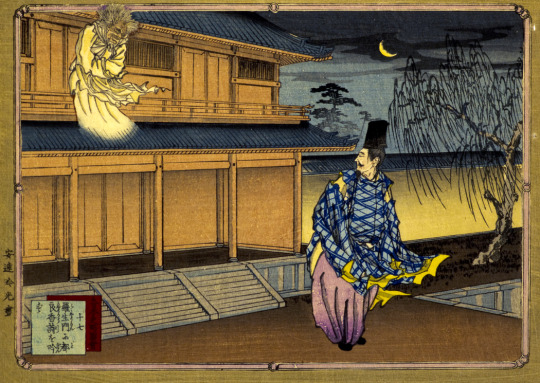
The oni of Rashomon and Miyako no Yoshika, as depicted by Ginko Adachi (Yokohama Art Museum; reproduced here for educational purposes only)
Some of you might wonder where Ibaraki-doji fits into this, considering the pretty direct reference to Yoshika's poetry in Wild and Horned Hermit. Masafusa, as a matter of fact, does allude to one more legend while highlighting Yoshika’s poetic talent, though he doesn’t go into detail. There’s no direct supernatural encounter - a nameless demonic inhabitant of Kyoto’s gate only hears a poem from passersby marveling at it and becomes “deeply moved”, but that’s it. The name Ibaraki-doji doesn’t show up at all, and there’s no mention of the oni finishing the poem, which is a mainstay of later versions.
Another of Masafusa’s works, Gōdansho (江談抄), also doesn’t use the name Ibaraki-dōji, or mention an actual encounter between Yoshika and the oni - he merely hears an unnamed passerby hum the poem and comments on it, calling it touching. However, the Kamakura period collection Jikkinshō already presents the version which gained the most traction in the long run, with the poem being a collaboration between Miyako no Yoshika and an oni. He later recites the full composition to Sugawara no Michizane, who is correctly able to point out only some of it is Yoshika’s own work, while the rest was added by an oni. However, once again, the name Ibaraki-doji is nowhere to be found.
On the other hand, while the story of Ibaraki-doji can be found in Taiheiki and other similar sources, it takes place far away from the capital in these early versions. The location was changed in noh adaptations of the legend to Rashomon, presumably due to its preexisting associations with supernatural creatures. By the time Toriyama Sekien published one if his famous bestiaries, Konjaku Hyakki Shūi, it seems the idea that the oni inhabiting this gate who was encountered by Yoshika and Watanabe no Tsuna’s nemesis Ibaraki-doji, who fought him there, were one and the same was already well established. Note that Sekien’s description of the oni of Rashomon actually doesn’t use the name Ibaraki-doji, though we do know he was aware of it.
It’s worth noting that the oni of Rashomon seemingly had a broader interest in fine arts, since there is also a legend in which he meets the famous biwa player Minamoto no Hiromasa and shows him his own skills with this instrument. However, this is ultimately not directly relevant to Yoshika, so you will have to wait until the next article, which will cover Shuten-doji and Ibaraki-doji in detail, to learn more.

The oni of Rashomon, as depicted by Toriyama Sekien (wikimedia commons)
Bibliography
Bernard Faure, From Bodhidharma to Daruma : The Hidden Life of a Zen Patriarch
Xiaofei Kang, The Cult of the Fox: Power, Gender, and Popular Religion in Late Imperial and Modern China
Zornica Kirkova, Roaming into the Beyond: Representations of Xian Immortality in Early Medieval Chinese Verse
Christoph Kleine & Livia Kohn, Daoist Immortality and Buddhist Holiness: A Study and Translation of the Honchō shinsen-den
Michelle Osterfeld Li, Ambiguous Bodies. Reading the Grotesque in Japanese Setsuwa Tales
Masato Mori, "Konjaku Monogatari-shū": Supernatural Creatures and Order
Masuo Shin'ichirō, Daoism in Japan (published in Brill’s Daoism Handbook)
Leslie Wallace, Betwixt and Between: Depictions of Immortals in Eastern Han Dynasty Tomb Reliefs
299 notes
·
View notes
Text
Canonical Batfamily Birthdays
Here are all the birthdates I know of that are canon somewhere in DC, with a preference for the main comics continuities. I have included exact sources and image references when possible. I am not including character introduction dates, just actual birthdays.
If you find any other sources for Batfamily birthdays, please do share!
A moment of silence for Batfamily characters who don’t have canonical birthdays yet, so far as I know. This includes Damian Wayne, Stephanie Brown, Duke Thomas, and more. :(
Summary
Source images will be further down, but here’s an overview in roughly age order (I’m not sure of Kate vs Selina’s ages) with the dates the birthdays were introduced and used:
Tim Drake: July 19th (from 2003)
Jason Todd: August 16th (from 2004)
Cassandra Cain: January 26th (from 2002)
Helena Bertinelli: February 14th (in the Batman: The Brave and the Bold universe, from 2010)
Helena Wayne: September 7th (from 1984), potentially October 20th or the 22nd of unknown month or maybe October 22 or maybe Feb 28th (all the New 52 on passports from 2011-2012). These could also be New 52 Helena Bertinelli’s birthdays or nobody’s birthdays. who even knows.
Dick Grayson: March 20th (from 1995), October ~24th ish (from 1990), November 11th (from 1976), December 1st (on Earth-16 in animated Young Justice universe, from 2012)
Barbara Gordon: September 23rd (from 1976), sometime in fall (from 1987)
Selina Kyle: March 14th (from 1976)
Kate Kane: January 26th (in Batwoman TV series from 2020), March 21st? (word-of-god by J.H. Williams III from 2012)
Bruce Wayne: October 7th (from 2021), February 19th (from 1970s various to more recently), April ~7th (from the late 1940s)
Jim Gordon: January 5th (from 1976)
Alfred Pennyworth: April 8th (from 1976), August 16th (in the Injustice: Gods Among Us universe, from 2016)
Note: in this post when I say “main comics continuity(s)/universe” I’m referring to anything that’s been a “home” continuity for the comics at some point. For example, pre-Crisis Earth-2, Earth-1/New Earth, and Earth-0/Prime Earth, as opposed to Elseworlds or DCEU earths that are still part of the broader DC multiverse but have never been the primary continuity of the comics.
Below are further details and source panels.
Details and Sources
Tim Drake
Tim has only been given one canon birthday. He turned 16 on July 19th in Robin Vol. 2 #116 (cover date Sep 2003).
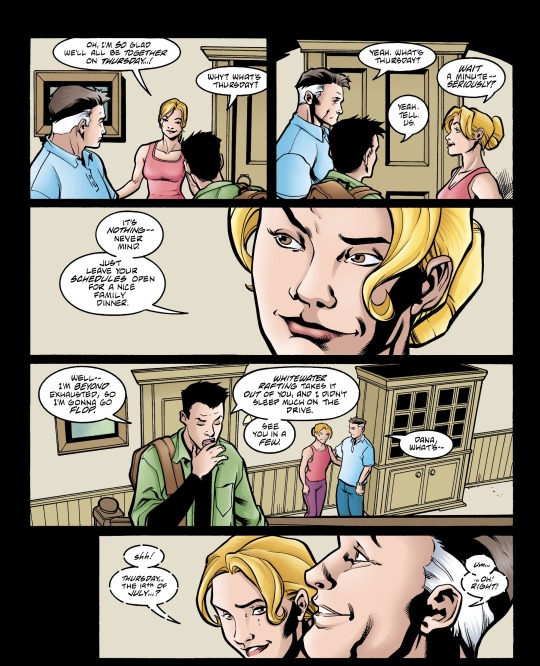
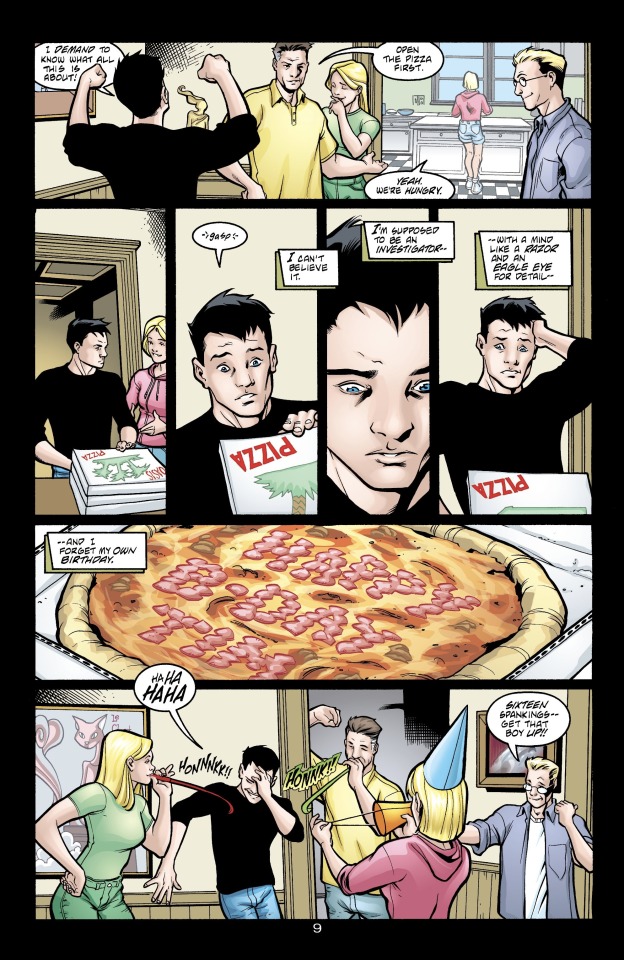
Robin Vol. 2 #116 (Sep 2003)
Jason Todd
Jason turned 18 on August 16th in Detective Comics #790 (March 2004). This is his only canon birthday.


Detective Comics #790 (Mar 2004)
In post-Crisis/preboot (1986-2011) continuity, there was a gap of six months between when Jason died and when he was resurrected (Batman Annual 25). Jason died April 27th according to his death certificates in Batman Annual 25 and Batman Files 2011, so he would’ve resurrected near late October.


Batman Annual 25 (May 2006)
So, it could be that post-resurrection Jason is biologically 6 months younger than he chronologically should be. But honestly, do we even really know what multiverse-breaking resurrection punches and then a Lazarus Pit on top of that do to someone’s body??? Either way it’s just much more simple to just use his chronological age.
Cassandra Cain
Much like Tim and Jason, Cass has only ever been given one birthdate: January 26th from Batgirl Vol. 1 #33. With that birthday, she turned 18 in Batgirl Vol. 1 #37.

Batgirl Vol. 1 #33 (Dec 2002)
When Jan 26th actually comes, Bruce suggests David Cain could’ve lied about it, but Cass denies that idea and continues to treat the day as her birthday.

Batgirl Vol. 1 #37 (Apr 2003)
Why it's likely her real birthday: Bruce initially believes Cain must’ve lied because he doesn’t think Cain could’ve known her birthday. However, we later learn Cain had lied about her origins and was actually her biological father. Batgirl v1 #62 and #73 show he was there for her birth and could absolutely know the date.
On top of that, in Batgirl #37 Cass remembers celebrating her birthday with him as a child, so he did seem to actually keep track of it. I honestly don’t see any reason to believe he’d lie (Bruce is just a jealous spoilsport).
Helena Bertinelli + Wayne
I’m combining them here because the New 52 gives me a headache.
Helena Bertinelli celebrated her birthday on February 14th in a spin-off comic from the animated Batman: The Brave and the Bold series. This is obviously not part of regular comics continuity and the characters differ from the usual comics in many ways. And yet, for reasons that will soon be clear, it’s my favorite for actually being about Helena Bertinelli the Huntress and for not being an utter mess.

Batman: The Brave and the Bold #14 (Apr 2010)
In a character profile at the end of Infinity Inc. #7 (Oct 1984), Helena Wayne’s birthday was September 7th, 1959. Calculating back from October 1984, that would make her 25 at the time.
During the New 52, Helena Bertinelli was initially portrayed as a long-dead (secretly alive but don’t worry about it) mobster’s daughter and replaced by Earth-2’s Helena Wayne who got stranded on Prime Earth. This H. Wayne stole H. Bertinelli’s identity in the form of several forged passports and IDs, which had hints toward birthdates. The question is, can we take any of those birthdates seriously, and if so, which birthdates and for which character? (Cue my headache.)
Skip ahead to Dick if overthinking fake passports sounds boring.
When comparing to a real Italian passport, the date on H. Wayne’s fake Italian passport appears to be a birthdate. Note that the fake name is Carol Bertinelli, not Helena. H. Wayne said her IDs were inspired by H. Bertinelli but clearly she’s taking liberties for the IDs so that’s a point toward these being useless for H. Bertinelli birthdays.

Huntress Vol. 3 #1 (Dec 2011)
I don’t recognize the month abbreviation as a real abbreviation, but from the visible letter O I’m going to assume it means October. If it is, then the date is 20 October 1985. Sidenote: a 1985 birthdate during 2011 could put her age at about 26, which is actually quite close to how old she could’ve been based on pre-Flashpoint! 1985 has been given as Helena Wayne’s death year before, so it’s an interesting choice of a birth year for her. (Thanks to DC’s sliding timescale, though, birth years don’t actually mean anything in the comics.)
They don’t show her complete US passport, but I can see a “22” in line where the day of the month should be for her birthdate. This already contradicts the previous passport. This one uses Helena Bertinelli’s actual name, though–does that make it more relevant than the Carol one or this all still ridiculous because of the discrepancies?

Worlds’ Finest Vol. 1 #1 (Jul 2012)
We can try to glean the US passport birth month from the passport number at the bottom. The first two digits (“12” here) indicate the agency that issued the passport. 12 means the Honolulu agency. Right after “USA” is supposed to be the birthdate plus an extra number, in the order of year/month/day with the year being the last two digits of a year. Here we encounter another problem. It says 810228. This would imply her birthdate is 1981/02/28. That’s February 28, 1981. Since the earlier line indicated her birthday fell on a 22nd, this already contradicts itself.

Interpreting a Machine Readable Zone (MZR) on a Machine Readable Travel Document (MRTD)
However, I’d bet comic writers and artists aren’t always well versed in passport numbers (it’s already a stretch for me to bother checking it…). If they put the extra digit before the birthdate instead after, and the date is formatted month/day/year (the most common format in American English, so probably their first instinct), then we can drop the first 8 and it’s 10/22/8[?] with the last digit unknown. This would put her birthday as October 22, sometime in the 1980s. The 22 matches the earlier line, the October might match the previous passport if that really did say October (but contradicts the 20th), and the 1980s year could be 1985 to match the Italian passport.
At the end of the day I’m personally just going to let Helena Bertinelli be a Valentine’s born baby and call it a day, unless/until she gets a better one in the comics. For Helena Wayne I’d easily pick September 7th.
(My question is: did they give the crossbow vigilante a Valentine’s birthday as a Cupid joke??)
Dick Grayson
Dick has probably had the most birthdays of everyone (unless Bruce has more I don’t know about). All of them have their drawbacks.
In a main comics continuity, his most popular and most recent is “the first day of spring” so probably March 20th. This comes from Robin Annual 4 when his mom says she calls him Robin because he was born on the first day of spring. That presents some problems since there are other explanations given for the origin of “Robin,” including that his mom said he was “always bobbin’ along” (Dark Victory #12, page 17) or the original inspiration of Robin Hood (Detective Comics #38, p3).
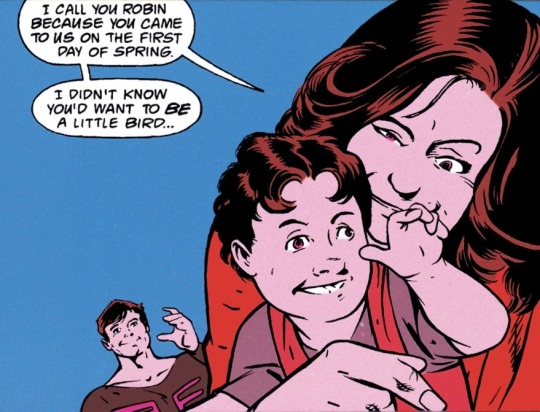
Robin Annual 4 (Jun 1995)
Before that, in Secret Origins Vol. 2 #50 (Aug 1990), Marv Wolfman wrote a version of Dick’s origins where Dick turned 10 a week before his parents died on Halloween. That would make his birthday October ~24th (presuming that “a week” before Halloween literally means 7 days here).

Secret Origins Vol. 2 #50 (Aug 1990)
The first drawback of the October birthday is that it’s tied to Dick being 10 when his parents die on Halloween. Dick’s age and the date his parents die change a lot depending on the writer (Nightwing Vol. 1 #1 says his parents died June 27th, Dark Victory #8-9 says May, etc.). The second drawback is that few people remember this version of his birthday even exists.
Dick’s birthday is November 11th in Super DC Calendar 1976. Note: Despite being a non-diegetic calendar from almost 50 years ago, this source remains well known and used among comic enthusiasts (including those working at DC). Generally, I would say it should mainly apply just to pre-Crisis continuity, but it is also useful for characters that haven’t gotten updated birthdays ever since (like Roy Harper, Barbara Gordon, or Selina Kyle, for example).
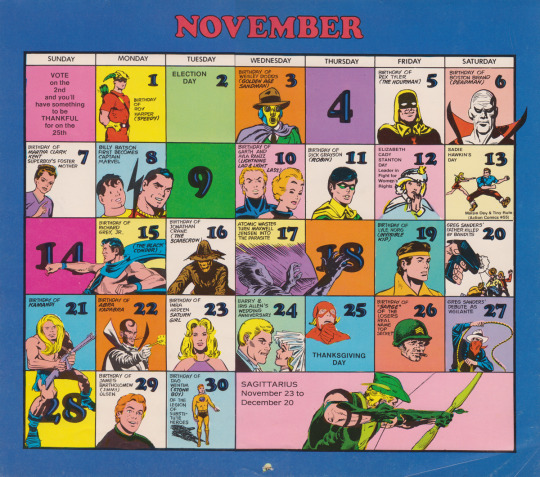
Super DC Calendar 1976
Sidenote: Since Damian doesn’t have a canon birthday, November 11th is favorite to steal for my own fan canon Damian birthday. Dick has plenty birthdays to share and I think it’s cute. @ DC, give Damian and Steph birthdays, they’ve been birthday-less for decades!
Indeed, DC writer Tim Sheridan and editor Mike Cotton debated whether Dick’s birthday was in March or November. They favored March 20th and wrote a birthday scene in Teen Titans Academy #1 (published March 23rd, 2021). The publishing time near Dick’s birthday was intentional, though the date isn’t mentioned within the comic itself.
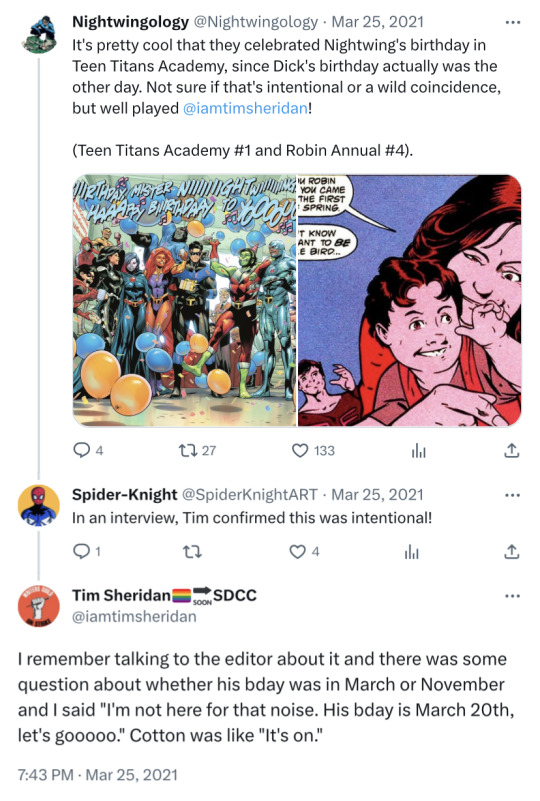
Link to tweet
The above birthdays were all meant to apply to a main comics continuity at some point. However, Earth-16, better known as the animated Young Justice universe (therefore outside of main comics continuity), says YJ Dick’s birthday is December 1st.

Young Justice Vol. 2 #20 (Nov 2012)
Unlike Helena Bertinelli, Dick has plenty of comics birthdays to choose from, so personally I’ll only count Dec 1st as being the birthday for YJ animated/Earth-16 Dick Grayson until or unless it’s ever mentioned to apply to main comics continuity.
Barbara Gordon
Super DC Calendar 1976 says Barbara’s birthday is September 23rd.

Super DC Calendar 1976
Since then, the only time I recall her birthdate hinted at is in Secret Origins #20 when her adoptive mom says her birthday is in the fall. This could support her birthday being September 23rd.
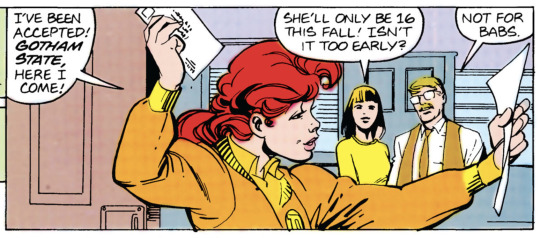
Secret Origins Vol. 2 #20 (Nov 1987)
Although she has celebrated her birthday on panel since then (the end of Nightwing Vol. 2 #153), she hasn’t been given any other actual birthdate. So I’ll keep September 23rd and call it a day.
Selina Kyle
Super DC Calendar 1976 says Selina’s birthday is March 14th. Once again, although it hasn’t been mentioned within a comic, it’s stuck around in popular consciousness (see: Catwoman actress Zoë Kravitz wishing Selina a happy birthday on March 14th).

Super DC Calendar 1976
Selina celebrated a birthday on panel in Catwoman (2002) #37 but the date was never mentioned. I don’t know of any other reference to her birthday, but my reading of Selina is thus far more sparse than my reading of the others.
Kate Kane
Kate’s birthday options all come from outside of the comics themselves.
In “An Un-Birthday Present,” season 1 episode 11 of Batwoman, a parallel version of her twin Beth had a driver’s license showing her date of birth as January 26, 1990. She and Kate later celebrated their birthdays on an episode aired Jan 26th, 2020. I don’t keep up with live action DC shows so I unfortunately can’t offer a screenshot (if anyone has one or the timestamp, please let me know!).
(I kinda wonder if somebody looked up Batwoman’s birthday for these episodes, saw Batgirl’s (Cass’s) birthday, and just ran with it. Batwoman and a Batgirl sharing a birthday is just. Ughhh.)
In 2012, one of her comic writers tweeted to choose a random date for her birthday and picked March 21st, which so far as I know has never been used as her birthday in comics.

Link to tweet
Bruce Wayne
Bruce’s most popular birthday is February 19th, but his most recent one is October 7th from the digital-only comic Legends of the Dark Knight. I believe that’s the only time October 7th has been referenced, but I’ve heard the animated show The Batman said his birthday was in October (can’t confirm, haven’t watched it recently).
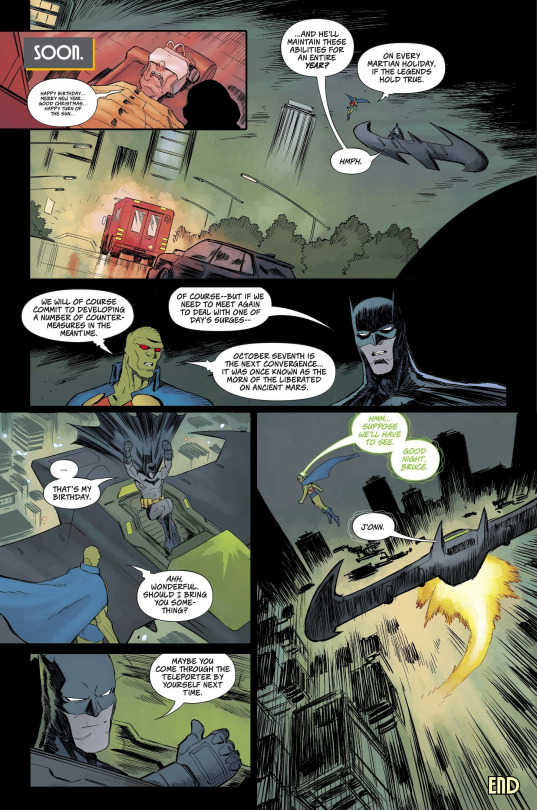
Legends of the Dark Knight #10 (Jun 2021) - Note: two pages have been combined into one for this post
Still, even associates of DC seem to remember his February 19th birthday better. In February 2023, Warner Bro’s Gotham Knights game did a sale for Bruce’s birthday. I’ve also heard the birthday was used in the Gotham TV show, but again, I don’t watch much live action DC shows.
The February 19th birthday appears to come from the 70s and 80s. It’s his birthday in the Super DC Calendar 1976, and in Batman Family Vol. 1 #11: “Suprise, Suprise!” (May 1977). Bob Rozakis (known as DC’s “Answer Man”) said Feb 19th was Bruce’s birthday in the letter column of Detective Comics #494 (Sep 1980).

Letter column of Detective Comics #494 (Sep 1980)

Batman Family Vol. 1 #11: “Suprise, Suprise!” (Jun 1977)
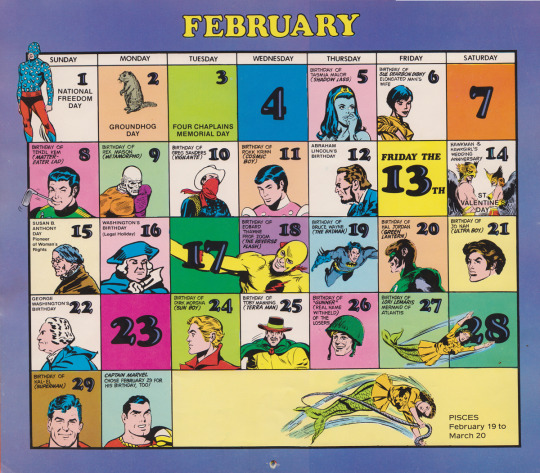
Super DC Calendar 1976
Way back in the 40s, his birthday was in April, possibly April 7th. During a birthstone murder mystery, Bruce says his birthstone is a diamond, which is traditionally the April birthstone.

World’s Finest Comics #33/6 (Mar-Apr 1948): “The 5 Jewels of Doom!”
Star Spangled Comics #91 (Apr 1949) might imply the exact date was April 7th but we’d have to assume the party is on his birthday and that “this month” refers to the publishing month of April. I believe this is where people get the April 7th birthday when they bring it up.

Star Spangled Comics #91 (Apr 1949)
Early April also shines in Batman: Year One where it shows Bruce’s first night out as Batman being either the night of April 6th or the early morning of April 7th (Batman #405). So although the April Bruce birthday hasn’t been used in decades, it’s still a Batman birthday in a way.
I have also heard people say Frank Miller considered Bruce’s birthday to be in November. However, I have yet to find an original source of him saying that, and honestly (just like the “March 21st” birthday for Kate) if he never used it in any canon material I don’t put much weight in that.
Jim Gordon
The only birthday I’ve ever seen for Jim is January 5th from Super DC Calendar 1976.

Super DC Calendar 1976
Alfred Pennyworth
Alfred’s birthday in Super DC Calendar 1976 is April 8th.
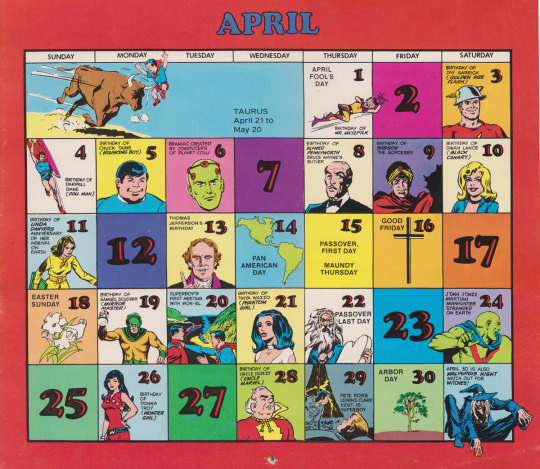
Super DC Calendar 1976
In the Injustice: Gods Among Us universe (an alternate reality where the video game of the same name is set in), they show Alfred’s birth certificate, where it says his birthday is August 16th, 1943.

Injustice: Gods Among Us Year Five #26 (Jun 2016)
Maybe you’ll notice that August 16th is Jason’s birthday. A little funny considering the issue features Alfred refusing to share his birthday only for us to learn it’s the same date as Jason’s. Still, annoying. There are so many days in the year! Stop choosing the same ones!
This Alfred birthdate runs into a similar problem Helena’s birthdates did: it’s not part of main comics canon, it’s an alternate universe, so it may not be applicable to the main comics universe.
Note: if we calculate that 1943 birth year from Jun 2016 when the comic was published, that’d make Alfred 72 soon to be 73. Does that mean anything in canon? Probably not, but oh well. Also...token British character born by Windsor Castle? …of course.
Personally, I would rather go with the April 8th birthday than the Injustice one, since Injustice is an alternate universe. Also, outside of the humor of it, the idea of Alfred and Jason sharing a birthday is a bit too much for me. Still, it’s up to people’s own cherry picking.
Chronology
The birthdays in publishing order alongside notable reboots. A soft-reboot refers to reboots that only changed a few details with minor consequences, keeping the overall continuity mostly intact. A major reboot has significant effects on continuity (too many to list).
1935-1986: Pre-Crisis era (Golden Age begins ~1946, Silver Age runs from late 50s--early 70s)
Mar-Apr 1948: Bruce’s birthday is in April
Apr 1949: Bruce has a birthday party on the 7th of “this month”
Skipping a good three decades because I barely even know what’s in there. Sorry lol
Mid 70s to early 90s: Bronze Age era
1976: the super dc calendar says Bruce’s birthday is February 19th, Alfred’s is April 8th, Dick’s is November 11th, Babs is September 23rd, Selina’s is March 14th, Jim’s is Jan 5th
Jun 1977: Bruce celebrates his birthday on February 19th
Sep 1980: letter collumnist says Bruce’s birthday is February 19th
Oct 1984: Helena Wayne’s birthday is on September 7th, 1959
Mar 1986: the major Crisis on Infinite Earths reboot (begins post-Crisis/New Earth era, many previous comics are now considered Earth-2 instead)
Nov 1987: Babs birthday is in fall
Aug 1990: Dick turns 10 a week before Halloween (probably October ~24th)
Sep 1994: Zero Hour soft reboot (Batman and Robin become urban legends so Robin is not allowed on video, Bruce’s parents’ murderer is changed to unknown instead of Joe Chill, Selina is no longer a once-prostitute)
Apr 1995: Dick’s birthday is the first day of spring (probably March 20th)
Oct 2002: Cass learns her birthday is January 26th
April 2003: Cass turns 18 on January 26th
Sep 2003: Tim turns 16 on July 19th
Mar 2004: Jason turns 18 on August 16th
Jun 2006: Infinite Crisis soft reboot (Joe Chill is restored as the arrested Wayne family murderer, Superboy-Prime's punch retroactively resurrects Jason)
Apr 2010: In the Batman: Brave and the Bold universe, Helena Bertinelli celebrates her birthday February 14th
Oct 2011: the major Flashpoint reboot (end of post-Crisis/preboot, begins the New 52 and changes the primary universe to Prime Earth; significant character/timeline changes and erasures)
Dec 2011: Helena Wayne’s fake Carol Bertinelli passport seems to list October 20th as a birthdate
Jul 2012: Helena Wayne’s fake Helena Bertinelli passport lists some 22nd unknown month, Oct 22nd, or Feb 28th birthday
Sep 2012: Batwoman writer J.H. Williams III randomly picks Kate’s birthday as March 21st on Twitter
Nov 2012: Earth-16/YJ animated Dick Grayson celebrates his birthday on December 1st
Jun 2016: In the Injustice: Gods Among Us universe, Alfred’s birth certificate says his birthday is August 16th
Jul 2016: Rebirth reboot (restores some pre-Flashpoint continuity, some characters regain previous histories but now semi-synchronized with the New 52 era)
Jan 2020: Batwoman TV show Kate celebrates her birthday on January 26th
Mar 2021: Writer Tim Sheridan says he & his editor chose March 20th as Dick’s birthday over the November option
May 2021: Infinite Frontier holds all previous continuities as potential canon, restoring more of pre-Flashpoint
Jun 2021: Bruce says his birthday is October 7th in a digital-only comic
Feb 2023: Gotham Knights game has a sale for Bruce’s birthday
#batfamily#batfam#tim drake#dick grayson#bruce wayne#dc continuity#heroesriseandfall#cassandra cain#dc comics#jason todd#helena bertinelli#selina kyle#barbara gordon#jim gordon#alfred pennyworth
89 notes
·
View notes
Text
Wet Beast Wednesday: blue whale
It's the one-year anniversary of my Wet Beast Wednesday posts. My first post was on the smallest of all cetaceans, the vaquita. For the anniversary, I'm going to go to the other end of the spectrum and cover the largest of all cetaceans: the mighty blue whale. Join me as we explore the biggest of bois, the largest of lads, and the absolutest of units.

(Image: a blue whale at the surface of the ocean, seen from above. It is long, slender, and grey. The head is the widest point and takes up about a quarter of the body. The blowholes are positioned at the back of the head. Two flippers emerge from the body just behind the head. The tail fluke is very broad and pointed. End ID)
Blaenoptera musculus, the blue whale, is divided into four subspecies based on size and location. These are the northern blue whale (B. m. musculus), the north Indian ocean blue whale (B. m. indica), the antarctic blue whale (B. m. intermedia), and the pygmy blue whale (B. m. brevicauda). The northern and pygmy whales are further subdivided into population stocks based on what part of their range they live in. Blue whales are not only the largest cetaceans, they are the largest known animals to have ever existed. There are animals that can get longer, like the lion's mane jellyfish, but blue whales are the most massive animals. There are some extinct species that could potentially meet or exceed the blue whale in size, including some ichthyosaurs, whales, and sauropods, but all those species are known only from skeleton fragments so we can't get a fully accurate estimate of their size. Size varies depending on subspecies and population stock, but the longest group are the eastern north Pacific population, which can reach an average 24 m (79 ft). The antarctic subspecies is the heaviest, averaging 130 metric tons (290,000 lbs) for females. Females are larger than males. The pygmy subspecies is the smallest, though small is a relative term as they can still average 21.3 m (69.9 ft) and 99 metric tons (218,000 lbs). The longest scientifically measured individual was 30 m (98 ft), though there are unconfirmed reports of longer ones. The heaviest blue whale on record weighed 173 metric tons (381,400 lbs), though there are whales estimated to get up to 199 metric tons (438,720 lbs). Blue whales also have the largest hearts of any animal. One specimen measured in at 180 kg (400 lbs). The heart is about the size of a golf cart and 4 or 5 people could fit inside the chambers without having to squeeze. There's a commonly-quoted factoid that a person could swim through a blue whale's arteries without touching the sides. I wasn't able to find any exact measurements to confirm or refute this. I did find some sources saying that the blood vessels are highly elastic so its possible the factoids are talking about the arteries at their most stretched. Each heartbeat moves 220 liters of blood and the total blood volume is estimated at 5,300 liters. The heartbeat can be heard two miles away. I really just want to impress on you that these animals are fucking massive. A study on hydrodymanics suggested that a blue whale couldn't get longer than 33 meters (108 ft) before its metabolic and energy requirements would exceed the amount of food it could eat. Blue whales are verging on what is theoretically the maximum amount of big a whale can be.

(Image: an illustration comparing the size of a blue whale to other animals and showing their size. The whale is about as long as a line consisting of a polar bear, grizzly bear, human, asian elephant, giraffe, and great white shark. End ID. Source)
Blue whales are baleen whales, meaning that instead of teeth they have thick, keratinous plates called baleen attached to the upper jaw. When feeding, blue whales open their mouths and swim through clouds of krill. The mouth can open to 80 degrees and folds at the bottom let it expand to fit 220,000 liters of water at a time. The whale them closes its mouth and forces water out through the baleen. The baleen acts as a sieve, trapping krill in the mouth to be swallowed. Blue whales target patched of krill with the highest densities as their feeding style requires a minimum of 100 krill per cubic meter to offset the energy cost of feeding. Most mouthfuls provide 8,312 to 475,141 kilocalories of energy, more than enough to offset the cost of feeding. The current estimate for how much krill an adult needs in a day is 1,120 ± 359 kg (2,469 ± 791 lbs) and pregnant females need even more than that. Blue whales will dive in search of food, with the deepest confirmed depth being a pygmy blue whale that reached 506 m (1,660 ft). The deepest known dive from a non-pygmy blue whale was 315 m (1,033 ft). The longest recorded dive was 15.2 minutes and the estimated maximum dive duration is 31.2 minutes. During dives, a blue whale's heartbeat slows to 2 beats per minute, the slowest of any known animal. The elastic aorta seems to take over a lot of the heart's pumping job during this time. Blue whales are streamlined and similar in appearance to the relates sei whales and fin whales. Blue and fin whales are capable of hybridizing and producing fertile offspring. 3.5% of the blue whale genome comes from hybridization with fin whales. While blue whales can produce hybrid offspring with fin whales, the reverse is not true and the gene flow from fin to blue is unidirectional. It appears that all hybrids are the result of a fin father and a blue mother. Interestingly, blue whales do not appear to be capable of hybridizing with the more closely related sei whales. There are unconfirmed reports of blue whale and humpback whale hybrids. And because someone was going to bring it up if I didn't, the blue whale's penis is the largest of any animal at 3 m (9.8 ft) long and 30 cm (12 in) wide and they can release an estimated 17 liters of semen at a time. I know someone out there desperately wanted to know that and to that person I say you're whalecum.

(Image: a blue whale feeding at the surface of the ocean on its side, seen from above. The mouth is open with the troat and lower mouth inflated. It is swimming into a patch of krill, visible as yellowish coloration in the water. End id)
Blue whales can be found worldwide, though they typically prefer colder water and do not enter the Arctic ocean. They are usually solitary or travel in pairs, but can gather in groups up to 50 strong when food is abundant. Many are migratory, feeding in cold water during the summer and moving toward the equator in winter. They can follow complex migratory patterns that have to be memorized. There are multiple different strategies employed by different populations regarding who migrates when and some populations don't migrate at all. Their vocalizations are used for long-distance and short-range communication and scientists have classified multiple different types of sounds produced. Different populations of whales have different patterns of vocalizations which may be akin to languages or dialects. Blue whale sounds are some of the loudest and lowest frequency produced by any animal and most are too low-frequency to be audible to humans. Mating season happens in winter. Males use vocalizations to attract females, who they then court through special noises, blowing bubbles, inflating their mouths, chasing, and slapping the water with their flippers. Males compete with each other for the chance to mate. Once a female chooses a male, they will mate and then separate. Gestation takes 10 to 12 months. Newborn blue whales are the largest babies in the animal kingdom at 6-7 m (20-23 ft) and 2-3 metric tons (4409 to 6614 lbs). Mother produce between 110 and 320 kg (240 - 710 lbs) of milk daily. Claves are weaned between 6 and 8 months once they hit 16 m (53 ft) and have gained about 17,000 kg (37,500 lbs). Females typically mate every 2 to 3 years. Blue whale become sexually mature at 8-10 years old and can live over 90 years, with the oldest on record being 110 years old. Their age can be determined by earwax, which is laid down in rings like trees.

(Image: a mother blue whale (background) and calf (foreground). The baby is already very large and is a lighter grey than the mother. The baby is seen from the sied while the mother is rotates to show her underside. End ID)
All blue whale subspecies are classified as endangered by the IUCN, with the antarctic subspecies being critically endangered. Blue whales were heavily impacted during whaling, with their population dropping to the point of near-extinction. Since the end of whaling, populations have risen to an estimated 10,000 to 25,000 as of the end of 2023. This is still smaller than their pre-whaling population, but they have recovered quite a bit. The current largest threats to blue whales are climate change, collisions with ships, and human created noise. The effects of anthropogenic noise from shipping lanes on aquatic animals is still poorly understood, though it seems to greatly irritate and even harm whales, forcing them to change their migratory routes and avoid shipping lanes. Interestingly, as the population has increased scientists have noted changes in courtship behavior and vocalization tone. It is hypothesizes that the increasing population is resulting in greater competitive pressure between males for the right to mate.

(Image: a blue whale seen from the side. Its head is toward the camera. The lower jaw as larger and thicker than the upper jaw. The animal is streamlined. The eye is just behind the mouth and small. Further back is a paddle-shaped flipper. End ID)
#wet beast wednesday#blue whale#whale#whales#cetaceans#cetacean#marine mammals#baleen whale#marine biology#biology#zoology#ecology#animal facts#informative#image described#science#absolute unit#big#anniversary
72 notes
·
View notes
Note
The tenth Doctor in journeys end (i think?) said a TARDIS is made to be piloted by 6 timelords, what roles would each have in the TARDIS?
What roles would six Time Lords have in piloting a TARDIS?
This is more speculative, based on the known features of a TARDIS.
Console Panels and Systems
A TARDIS console is split into six 'panels', with each panel operating a different aspect of the TARDIS' systems. When there are six pilots, each Time Lord would likely specialise in operating a specific panel and system. Although the console layout may change with each TARDIS's 'desktop theme,' the six fundamental panels remain the same.
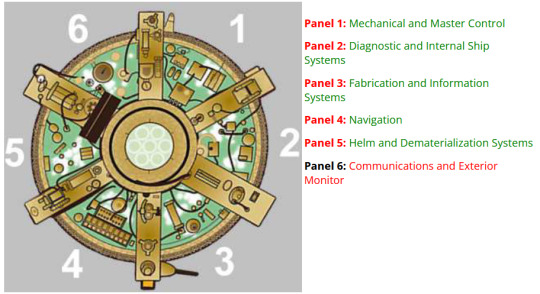
[Image ID: On the left is a top-down diagram of the 9th and 10th Doctor's coral theme TARDIS, divided into six panel sections. Each section is labelled from 1-6 clockwise starting from the 12 o'clock position. On the right is a text list of the panels and their names: Panel 1: Mechanical and Master Control, Panel 2: Diagnostic and Internal Ship Systems, Panel 3: Fabrication and Information Systems, Panel 4: Navigation, Panel 5: Helm and Dematerialisation Systems, Panel 6: Communications and Exterior Monitor./.End ID]
See this page on the TARDIS Technical Index for more variations on desktop themes.
👨✈️ Roles and Responsibilities
Here's a breakdown of each potential role and their responsibilities:
🔧 Panel 1: Mechanical and Master Control
Role: Chief Engineer
Responsibilities: The chief engineer monitors the TARDIS's overall operation. They ensure that all the mechanical systems and master controls are working properly. If anything goes wrong, they step in and fix it.
🛠️ Panel 2: Diagnostic and Internal Ship Systems
Role: Systems Analyst
Responsibilities: This person is all about the internals. They monitor life support, environmental controls, and the internal power grid. Basically, they make sure everything inside the TARDIS is working as it should.
🖥️ Panel 3: Fabrication and Information Systems
Role: Data Specialist
Responsibilities: Managing the TARDIS’s databases and info systems, and handling any fabrication needs. Whether it’s creating new tools, repairing old ones, or just making sure the information systems are up-to-date, they’ve got it covered.
🧭 Panel 4: Navigation
Role: Navigator
Responsibilities: Plotting courses through time and space. The Navigator makes sure the TARDIS lands where it’s supposed to, calculating all those tricky temporal vectors and spatial positions. They work closely with the Pilot to make sure the journey is smooth and safe.
🚀 Panel 5: Helm and Dematerialisation Systems
Role: Pilot
Responsibilities: This is the person at the helm, controlling take-off, landing, and in-flight manoeuvres. They handle the dematerialisation and rematerialisation of the TARDIS, making sure it takes off and lands without a hitch.
📡 Panel 6: Communications and Exterior Monitor
Role: Communications Officer
Responsibilities: They handle all external communications and keep an eye on what’s going on outside, involving sending or receiving messages or watching out for any threats or anomalies.
🏫 So...
Potentially, each Time Lord on the TARDIS would have a specialised role associated with a specific panel. Ideally, they're probably all working together like a well-oiled machine. However, poor old solo pilots have to jump around like madmen trying to cover all the controls at once.
Related:
Do we have any info on TARDIS biology?: Overview of TARDIS biological aspects.
Can a non-Gallifreyan benefit from a symbiotic bond with a TARDIS?: Non-Gallifreyan symbiosis with a TARDIS.
How to locate a TARDIS pilot: Guide for locating a pilot or other crew members using the TARDIS.
Hope that helped! 😃
Any purple text is educated guesswork or theoretical.
More content ...
→📫Got a question? | 📚Complete list of Q+A and factoids
→😆Jokes |🩻Biology |🗨️Language |🕰️Throwbacks |🤓Facts
→🫀Gallifreyan Anatomy and Physiology Guide (pending)
→⚕️Gallifreyan Emergency Medicine Guides
→📝Source list (WIP)
→📜Masterpost
If you're finding your happy place in this part of the internet, feel free to buy a coffee to help keep our exhausted human conscious. She works full-time in medicine and is so very tired 😴
#doctor who#gil#gallifrey institute for learning#dr who#dw eu#gallifrey#gallifreyans#whoniverse#ask answered#gallifreyan culture#tardis
44 notes
·
View notes
Note
Hi! I was wondering if you have any thoughts or resources on the Highlander/Highland Lynx breed? Or what, if any, is the difference between the two?
I've read that they're two different breeds, but that that may only be the case because of different registry requirements..??
Also, are they really truly domestic? Every where I've read has said that they most certainly are, but that they're also crossed with Jungle Curls? That bit has left me a bit confused...
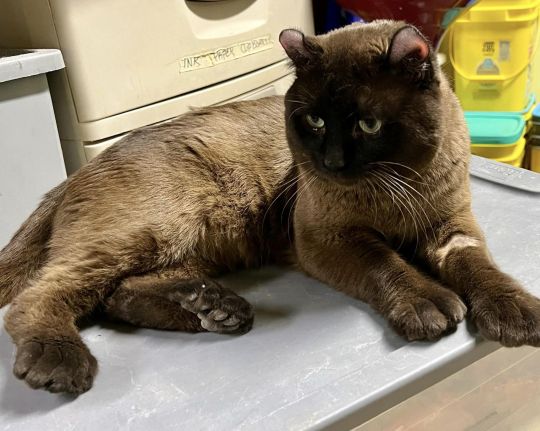
https://www.petfinder.com/cat/sampson-71366971/wi/new-richmond/gregorys-gift-of-hope-inc-wi432/
This pretty little guy is up for adoption at a shelter near me, and I'm contemplating going to see him (if he isn't snapped up in the next week lol), but I'd like to cover all my bases for breed research first!
He apparently came in fully intact and was recently neutered which seems.... Strange to me. The people who surrendered him supposedly bought him from a breeder out of state?
I'm not by any means 100% certain, but i did look at a few Highlander catteries and I THINK I may have found his breeder? At the very least they have a king that very well looks like he could be this guy's sire
https://www. highlanderswildnwonderful.com/ Kings.html
I do still wonder why he would be sent out as a companion fully intact though... Or why he wound up in a shelter and not returned to the breeder...
Anyway! I'd love to hear thoughts/opinions resources for potential health issues
So far I've only read that they require frequent ear cleanings and have some UTI issues, but the stumpy tail does make me a little nervous... It doesn't seem to be the same thing as manx, buuuuuut......
Woah, amazing find!
From what I understand - and if this isn’t correct someone more familiar with the breed is welcome to correct me - but the Highland Lynx is essentially the outdated name for the breed more widely known as the Highlander.
The exception largely being the Rare and Exotic Feline Registry which has decided the Highland Lynx is still the Highland Lynx and the Highlander is the same thing but backcrossed to the Desert Lynx use in the breeds foundation.
Which doesn’t make sense to me, it should just be considered an allowable outcross…? But whatever. I don’t respect that registry anyways.
As for their domestic vs hybrid status it’s true that the Jungle Curl is a Jungle Cat and American Curl but it seems like the Highlander falls more into the Toyger realm… there are technically wild caat hybrids in the ancestry but they’re far enough removed that it isn’t super relevant.
Even after 4 generations a cat is largely considered domestic or “SBT” (Stud Book Traditional) and these guys are generally even further out than that.
Before I get into the health of the breed I just need to make a small correction to their description… this handsome fella is not chocolate, he’s black sepia - often called brown or sable, sometimes called natural.
The toe beans tell, and he has many beans to reveal his secrets.
Currently we are not aware of any issues related to curled ears the way there are with folded ears but anecdotal evidence suggests that they’re more fragile and.. yes, require more frequent cleaning. Dirty ears and ear infections are definitely something to be mindful of.
As much as I enjoy polydactyl cats I’m not a fan of deliberately breeding for the trait, the nails on these extra digits can be difficult for the cat to maintain and are more prone to becoming ingrown. Some cats even require an onychectomy (declaw) of the excess digits due to reoccuring problems.


[Image Source]
So acclimating to having their paws handled and tolerating routine nail clips is an absolute must.
And finally… the tail.
Your concern about the relation to the problematic manx gene is warranted.
There are presently two types of tail mutations documented in domestic cats: the “natural bobtail” manx gene due to T-box mutations and the “asian bobtail” due to an HES7 mutation. The latter is not presently associated with the same issues as the manx gene.
HES7 mutations are not present in the Highlander.
Two T-box variants have been identified in the Highlander breed, meaning the mutation for their bobtail is the same as those responsible for the manx. Standard Highlander’s can have no tail to a short tail, those with a long tail are considered non-standarf and are largely used only for breeding purposes due to the lethal nature of T-box mutations when homozygous.
Some Highlander lines owe their bobtail appearance to a “novel variant,” meaning no known mutation has been identified. As this variant or variants are currently unidentified we can’t confidently say which gene (if either of them) it’s most closely related to or if there are similar issues associated.
All that being said not all manx gene cats will present with related problems and for those who do the severity is variable, some may have minor issues that can be managed with diet or medication while others may be… pretty severely effected.
I imagine at this age they would have a good idea of if Sampson has any issues and to what degree they’re present if he does.
If you’re prepared to deal with potential health issues should they arise I think it would be lovely to adopt him, you’re not contributing to the breeding of more if you go through a rescue and are equipped to educate others on why “Yes, mine is awesome but no you don’t actually want one.”
Like Dr. Frank Bozelka and his rescue Scottish Fold. His videos are hilarious and informative, by the way, I definitely recommend giving him a follow.
It would also be good for him to be placed with someone aware of and prepared to accomodate possible breed-related issues instead of someone who just wants a fancy cat… but I understand this can also be overwhelming, so absolutely no judgement if you decide to pass.
But if you do adopt him I’d love to see more pictures! I want to squish his cheeks.
54 notes
·
View notes